
ONE HUNDRED DRAWINGS AND WATERCOLOURS
From the 18 th to the 21 st Centuries



From the 18 th to the 21 st Centuries

To be exhibited at Ground Floor, 6 Mason’s Yard, Duke Street, St James’s, London SW1Y 6BU
FREYA MITTON
20 TH CENTURY BRITISH ART
Tel: +44 (0)7968 562 499 freya@freyamitton.com www.freyamitton.com
Front cover: Edward Robert Hughes, RWS (1851-1914) Study of a Young Girl [cat.37]
Opposite page: Sir Eduardo Paolozzi, RA (1924-2005) Spaceship and Parrot [cat.83]
Back cover: Edward Henry Fahey (1844-1907) Looking out to Sea [cat.26]
GUY PEPPIATT
FINE ART
Tel: +44 (0) 20 7930 3839 or +44 (0) 7956 968 284 guy@peppiattfineart.co.uk www.peppiattfineart.co.uk
HARRY MOORE-GWYN
BRITISH ART
Tel: +44 (0)7765 966 256 harry@mooregwynfineart.co.uk www.mooregwynfineart.co.uk
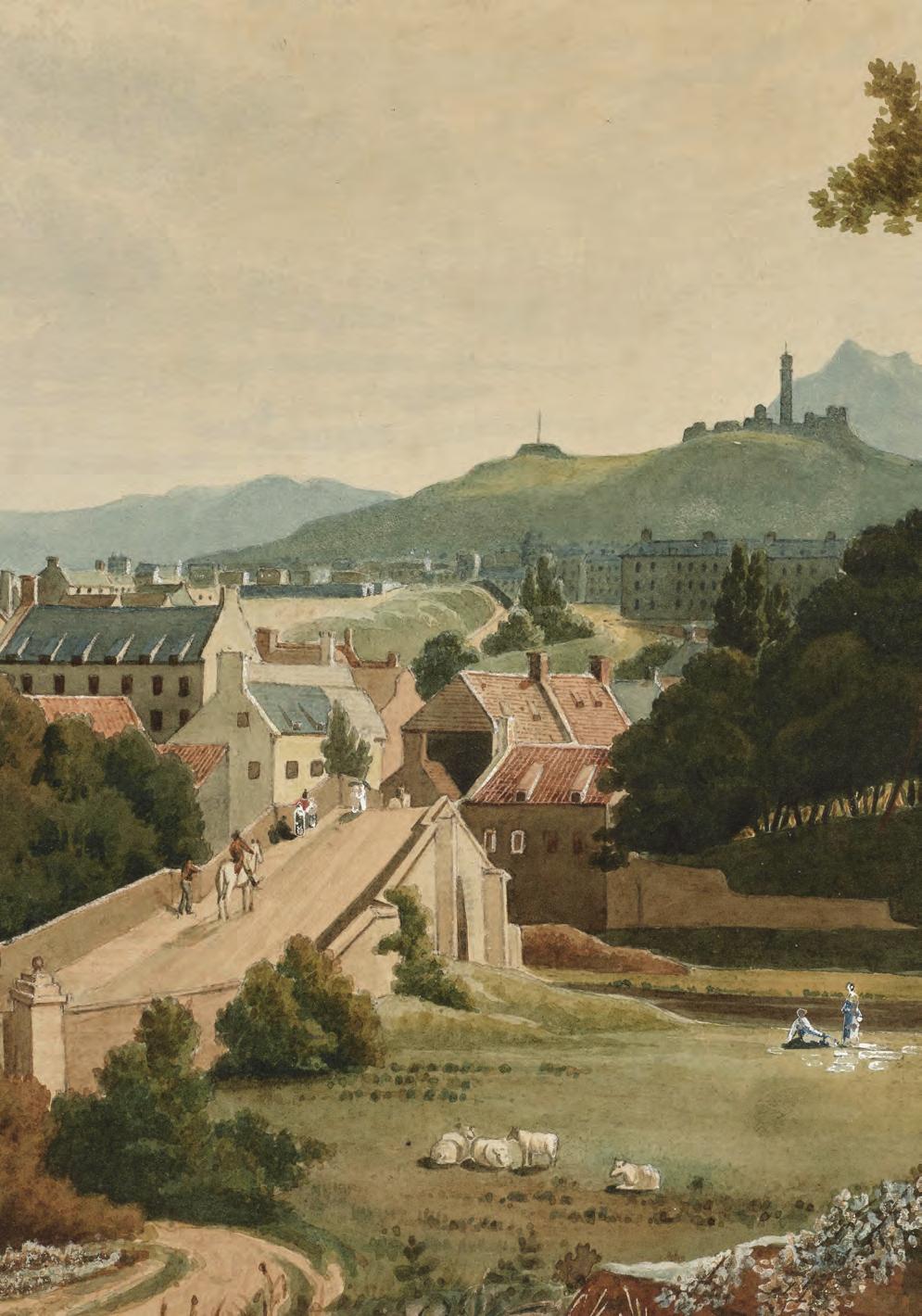
Freya Mitton, Harry Moore-Gwyn and Guy Peppiatt are very pleased to present our second combined Winter catalogue of British Drawings and Watercolours at 6 Mason’s Yard. The exhibition will run from the end of November 2024 with remaining works being on show in the gallery until the middle of January 2025.
By focusing again on works on paper (and watercolour in particular), our exhibition attempts to highlight the depth and variety of this distinctively British of mediums, presenting a wide selection of pictures by artists from some four centuries.
With prices starting at only a few hundred pounds, our catalogue is, we also hope, a testament to the astonishing value for money that British drawings and watercolours still represent in today’s market. We very much hope there is something that appeals to you from the catalogue and we look forward to welcoming you at 6 Mason’s Yard over the next few months.
Freya Mitton
Harry Moore-Gwyn Guy Peppiatt
Opposite page: George Hilditch (1803-1857) Calton Hill and Arthur’s Seat, Edinburgh from Stockbridge [cat.10]



The Pantiles, Tunbridge Wells
Watercolour over pencil heightened with bodycolour with black in border 23 by 39.5 cm, 9 by 15 ½ in.
Although unsigned, this seems likely to be a rare work by Thomas Loggon. Born in Great Grimsby, Lincolnshire he started his career as dwarf for the Prince of Wales. An aquatint of this view after Thomas Loggon published by Sir Richard Phillips in 1804, but depicting a scene from 1748, is annotated with the names of the figures depicted. It is interesting to note that the three figures in the centre of our watercolour bear a strong similarity to a group identified as Mr Nash, Miss Chudleigh (Duchess of Kingston) and Mr Pitt (Earl of Chatham). Mr Nash is the celebrated dandy ‘Beau’ Nash (1674-1761), who appointed himself Master of Ceremonies for Tunbridge Wells in 1735. Elizabeth Chudleigh (c.1720-1788), was a courtier and bigamous wife of the 3rd Earl of Bristol and the 2nd Duke of Kingston. ‘Mr Pitt’ is William Pitt the elder, 1st Earl of Chatham (1708-1778) and later Prime Minister.
The discovery of a mineral spring in 1606 led to the foundation of the spa town of Tunbridge Wells and within 24 years, its first Royal visitor, Queen Henrietta Maria, who stayed six weeks, secured its place as a tourist destination of note. The area was subsequently paved with the local pan-baked clay tiles, which gave the area its name. The artist has captured the elegant row of shops and coffee house, with elegant figures on the Upper Walk, parading beneath the soaring trees of the Lower Walk.
A further watercolour depicting the same view and intended as the central portion of a fan by Loggon, is in the British Museum.

[cat.2]
Signed and dated on a gravestone lower centre: S. H Grimm/fecit 1785 and inscribed and dated on the original washline mount: S. East View of Blackwell Church, 1785 Pen and grey ink and watercolour on laid paper 26.5 by 37.7 cm, 10 ½ by 14 ¾ in.
Provenance: With the Fine Art Society, London, 19th November 1971, no. 9279; Anonymous sale, Sotheby’s, 5th July 2017, lot 170, where bought by the present owner
The present watercolour depicts the church of St John the Baptist in the village of Tibshelf which lies about two miles to the north of the village of Blackwell. The church was originally founded in the twelfth century and largely rebuilt in 1729, apart from the fifteenth century tower, which remains. The church was further altered in the late 1880s.
Swiss born Grimm moved to England in circa 1768, where he was initially employed as a travelling companion and recorder of ‘anything curious’ by Sir Richard Kaye, rector of Kirby in Ashfield, in 1765. By 1775 Grimm was in Derbyshire and Staffordshire and three years later he appears to have moved to London.

The present drawing once formed part of a sketchbook from 1793, which was apparently inscribed ‘Opening of the Ark’. It included studies for a range of subjects including Opening of the Ark, Canidia and the Youth, L’allegro, and Titania’s Chariot as well as figure studies, including of Lady Hamilton. It has not as yet been possible to identify the subject of this drawing, the large urn or vase behind the crouching figure suggests that it may have been intended to have an Orientalist flavour, perhaps inspired by Milton. The statuesque female figure, may be intended to be a priestess or sorceress, standing next to a fire. The crouching figure bears a similarity to the later Lapland witch subjects that Romney was exploring later in the decade.
[cat.3a]
Study of Figures by a Fire
Pencil
14 by 9.5 cm, 5 ½ by 3 ¾ in. Provenance: Mrs Alister Mathews; Anonymous sale, Sotheby’s, London, 13th March 1986, lot 64 (part); Private Collection, London

[cat.3b]
Study of a Woman in profile
Pencil on laid paper
Sheet 19 by 12 cm, 7 ½ by 4 ¾ in.
This drawing originates from an album of sketches by Romney dated to May 1777. Portraits he was working on at the time include ‘The Dancing Gower Children’ and ‘Catherine Vernon as Hebe’. Other intact sketchbooks from this period are in the Victoria and Albert Museum and the Fitzwilliam Museum, Cambridge. A sketchbook from late 1777/early 1778 is in the Walker Art Gallery, Liverpool (see Alex Kidson, George Romney, exhibition catalogue, 2002, p.140-1, no.77).
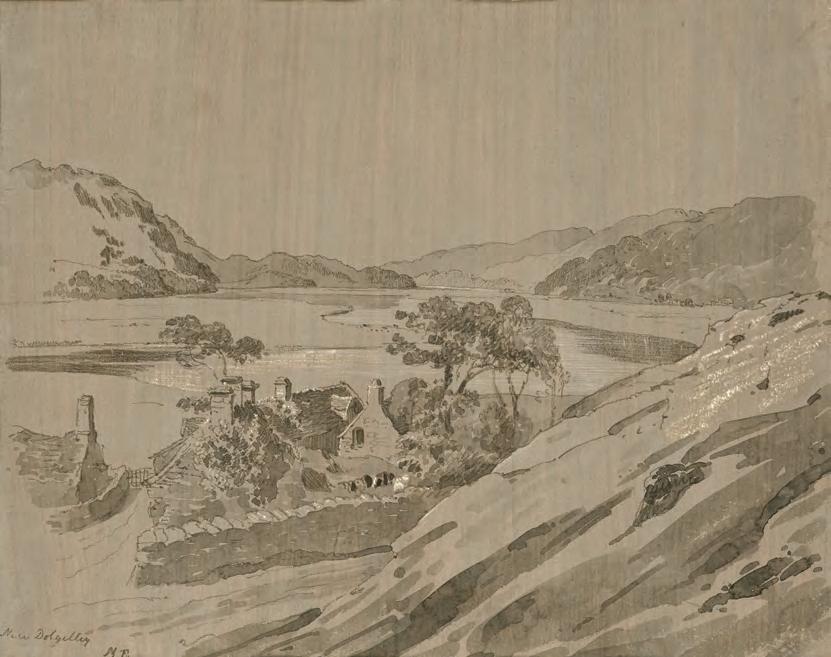
Inscribed lower left: Near Dolgelley/N.E. Pencil and black wash on prepared grey-brown paper heightened with scratching out 24.2 by 30.5 cm, 9 ½ by 12 in.
Provenance: With Walker Galleries, 1961; Private collection, Herefordshire to 2024
Tudor was born in Monmouth, the son of Owen Tudor, a bookseller. He started drawing at a young age, providing plans and drawings of local houses and first exhibited at the Royal Academy in 1809. He continued exhibiting until 1819 but became a land agent, building Tudor House at Wyesham near Monmouth where he lived for the rest of his life. He was also a collector of paintings and owned works by Reynolds, Van Dyck and Turner whose studio his diary records he visited in June 1847.

[cat.4b]
Inscribed lower centre: Near Barmouth. W
Pencil, pen and ink heightened with scratching out on prepared grey paper
23.4 by 29.7 cm, 9 ¼ by 11 ¾ in.
Provenance: With Walker Galleries, 1961; Private collection, Herefordshire to 2024


Melton Constable Church, Norfolk
Signed lower right: Melton Church Nork. JS Cotman
Pencil
15.5 by 23.7 cm, 6 by 9 ¼ in.
Provenance: With The Fry Gallery; Anonymous sale, Christie’s South Kensington, 8th December 2011, lot 402; Private Collection, London
Melton Constable is the seat of the Earls of Hastings and the church of St Peter’s built in 1092, was originally the estate church. The simplicity of the Norman exterior belies the ornateness of the interior; the result of the Hastings Mausoleum, which fills the south transept and houses the family pew and a series of ornate memorials to the Astley family. Cotman depicts the church from the south-east, looking toward both the south transept and the East End. The window in the south transept has been altered subsequently, as has the pitch of the roof on the central tower.
There is a reference to a work of similar size to the present drawing, depicting Melton Constable Church, Norfolk, from the South East, which is also signed and was formerly in the Bulwer Collection (C.F. Bell, ‘John Sell Cotman, (The Bulwer Collection)’, Walker’s Quarterly, 1925, no.69). Although whether this is the present drawing, or another version is uncertain. The Bulwer Collection also included a view of Melton Constable House by Cotman which was engraved for Excursions through Norfolk, published in 1819 (Bell, op.cit., no.106).

[cat.6]
Glastonbury Abbey from the Nave, with a distant view of the Tor
Signed and dated lower right: J. Buckler 1825.
Pen and ink and watercolour over pencil 26.6 by 39.2 cm, 10 ½ by 15 ½ in.
Provenance: Anonymous sale, Sotheby’s 19th July 1979, lot 81, where bought by the present owner
Glastonbury Abbey was founded in the eighth century and enlarged in the tenth. It was almost completely destroyed by a fire in 1184 and having been rebuilt, it was suppressed and closed down by Henry VIII in the 1530s. Beyond is Glastonbury Tor on which sits the ruins of St Michael’s church. Both buildings have been linked with the legend of King Arthur since at least the twelfth century.
Buckler was a talented topographical artist, as well as antiquarian and architect. His watercolours are influenced by his architectural training and are characterised by a careful pen line and an extraordinary attention to detail, as evidenced by the present view. He began his career in assisting his father, John, also an artist and architect.

[cat.7]
Black chalk on grey paper
27.8 by 18.8 cm, 11 by 7 ¼ in.
Provenance: With Morton Morris & Company, London, 1982; Private Collection until 2024
Literature: Morton Morris & Co., Sir George Hayter and John Hayter, 1982, p.39, no.100
Exhibited: London, Morton Morris & Co., Sir George Hayter and John Hayter, 27th October to 26th November 1982, no.100 as ‘A street scene, presumably in London, at dusk’
This is a view looking south down Fish St Hill towards the Monument to the Great Fire of London designed by Sir Christopher Wren. Beyond is the steeple of St Magnus the Martyr which was also built by Wren.
Landscape drawings by Hayter are rare - he is best known for his portraits of Queen Victoria and the Duke of Wellington. He exhibited extensively at the Royal Academy and elsewhere from 1815.

Inscribed verso and in another hand on the mount: Kensington Gardens. 4 o’clock. 9 July 1822
Black and blue chalk on blue paper
14.5 by 22.7 cm, 5 ¾ by 9 in.
Provenance: John Hayes
Crotch was born in Norwich and achieved early fame as a musician. At the age of four, he was giving daily organ recitals in London and composed his first oratorio aged 11 when studying music in Cambridge. In 1790 at the age of fifteen Crotch was appointed organist of Christ Church College and became a Professor of Music in 1797. He returned to London and was the first Principal of the Royal Academy of Music from 1822 until 1832 – many of his known drawings date from 1832 onwards. He was a talented artist and draughtsman and usually inscribed the reverse of each drawing with a place, date and often the precise time.
In May 1821 the Crotches moved to a new house at Kensington Gravel Pits on the north side of Hyde Park, now part of the Bayswater Road. In 1822, the amateur composer Lord Burghersh founded the Royal Academy of Music which was based at Tenterden St off Hanover Square. An early pupil, Sir William Sterndale Bennett (1816-1875), wrote his recollections of Crotch: ‘An active man, he used to walk from his house in the neighbourhood of Campden Hill to Tenterden Street, entering his classroom distended by paint-boxes and sketch-books, and allowing his pupils, to their great delight, to examine any additions he had made on his walk through Kensington Gardens’ (see Jonathan Rennert, William Crotch (1775-1847) – Composer, Artist, Teacher, 1975, p.66).

[cat.8b]
The Brunswick Tower, Windsor Castle
Extensively inscribed verso including: The Wyatville Tower or Brunswick Tower/July 12 1832 1pm/Saw the Duke of Cumberland’s relation/I believe that is her with y.e Parasol and further inscribed on part of original mount
Watercolour on black chalk
13.9 by 22.7 cm, 5 ½ by 9 in.
During the reigns of George IV and William IV, Sir Jeffry Wyatville R.A. (1766-1840), nephew of the Surveyor of Windsor Castle, James Wyatt, P.R.A. (1746-1813) was employed to continue work on the ongoing restoration and development of Windsor Castle, that had been started by his uncle. The octagonal Brunswick Tower was built between 1825 and 1834 on the site of a smaller 12th Century rectangular tower.

[cat.9a]
William Green (1760-1823)
Leathes Water from the West, Cumbria
Watercolour
12.7 by 19.2 cm, 5 by 7 ½ in.
Provenance: With the Lyver and Boydell Galleries, Liverpool
William Green was born in Manchester and worked as a surveyor before studying engraving in London. In 1800 he moved to the Lake District living on Market Square, Ambleside. He specialised in watercolours and prints of the Lakes which his daughters sold from premises in Ambleside and Keswick.
Leathers Water also known as Wythburn Water and Thirlmere was a small lake in Wythburndale which became part of the new reservoir of Thirlmere created in the 1880s. An aquatint taken from this viewpoint by Green was published on 24th June 1804.

[cat.9b]
William Green (1760-1823)
Buttermere Bridge and the Bridge Inn, Cumbria
Watercolour
13.1 by 19.2 cm, 5 by 7 ½ in.
Provenance: With the Lyver and Boydell Galleries, Liverpool

[cat.9c]
Watercolour
13.1 by 19.4 cm, 5 by 7 ½ in.
Provenance: With the Lyver and Boydell Galleries, Liverpool
Kentmere Hall, in the Kentmere Valley in the southern Lakes, consists of a 14th century pele tower which was later enalarged into a farmhouse. The original turrets, window and spiral staircase still exist. An engraving of this view by Green was published on 1st August 1814.

[cat.10]
Calton Hill and Arthur’s Seat, Edinburgh from Stockbridge
Signed on label attached to the backboard: Edinburgh 1828/from Carron Road/George Hilditch
Watercolour over pencil heightened with white 22.5 by 31cm, 8 ¾ by 12 ¼ in.
This is a view of Edinburgh from the north taken from Stockbridge. The bridge in the foreground is likely to be St Bernard’s Bridge, a stone bridge built to cross the Water of Leith in 1824 (the present watercolour is dated 1828). The Nelson Monument on Calton Hill, visible here, was built by Robert Burn between 1808 and 1815. Construction of The National Monument was started in 1826 but it was abandoned due to lack of funds in 1829.
This is a rare watercolour by the London-based landscape artist who exhibited oils at the Royal Academy and elsewhere between 1823 and 1856.

[cat.11a]
The Old Church, Chingford, Essex
Signed lower left: J. VARLEY/1821
Watercolour over pencil
28.5 by 48 cm, 11 ¼ by 18 ¾ in.
Exhibited: London, Society of Painters in Water-colours, 1822, no.148 as ‘Chingford Church, Essex - Study from Nature’; Falmouth, Falmouth Arts Centre, 200 Years of British Watercolours 1775-1975, 13th to 24th July 1976
The Church of All Saints, Chingford, known as the Old Church, was the parish church until 1844 when it fell into disrepair and was abandoned. It was known as the ‘Green Church’ as it was covered in ivy and was a popular subject for Romantic artists, most famously Arthur Hughes who depicts it in ‘Home from Sea’ in the Ashmolean Museum, Oxford. It was restored in the 1930s.

Signed lower right: J. Varley and inscribed by artist on old backing: Gypsey scene near Hounslow Heath. J. Varley
Watercolour over traces of pencil
17.9 by 23.6 cm, 7 by 9 ¼ in.
Provenance: John Theobald, 42 Carmarthen St, London, 1825; Bought at Agnew’s; By descent until 2020
Exhibited: London, Society of Painters in Water-colours, 1825, no.129, bt. Theobald
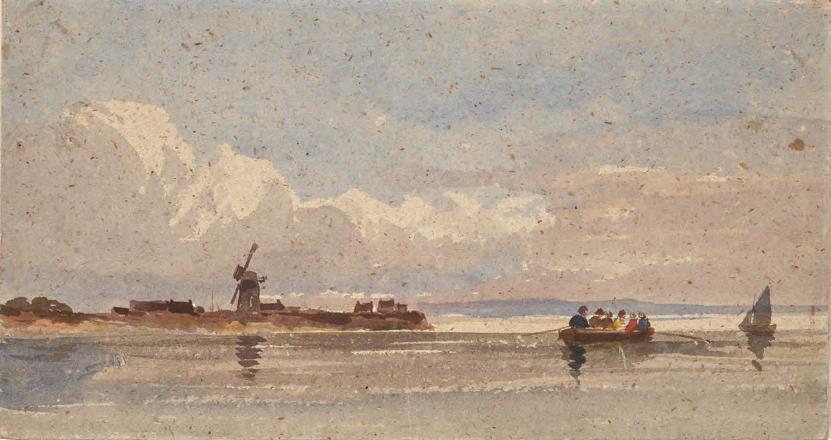
[cat.12a]
David Cox (1783-1859)
Boats near a Windmill on the Thames Estuary
Watercolour heightened with touches of bodycolour on laid paper 11.8 by 22.3 cm, 4 ½ by 8 ¾ in.
Cox drew a number of views on the Thames estuary in the late 1820s and early 1830s, the date of the present watercolour.

[cat.12b] David Cox (1783-1859)
Watercolour over black chalk on laid paper 12.4 by 16.7 cm, 4 ¾ by 6 ½ in.
Provenance: With the Fine Art Society, London, May 1939; G.W. Macfarlane
This sketch dates from the mid to late 1830s.

Harvesters near Richborough Castle, Kent
Signed, dated and inscribed, lower left: Wm. Evans. 1837/Richboro’ Castle/as seen from the/Isle of Thanet Watercolour over traces of pencil heightened with bodycolour and stopping out 19.6 by 34.5 cm, 7 ¾ by 13 ½ in.
Provenance: With Martyn Gregory, London, 1997; With Spink and Son, London; Private Collection until 2024
Literature: Martyn Gregory, William Evans of Bristol (1809-1858), 1987, p.10, no.5, ill.
Exhibited: London, Martyn Gregory, William Evans of Bristol (1809-1858), 10th to 28th November 1987, no. 5
Evans was born in Bristol and was a pupil of Francis Danby in 1826. He is recorded as a drawing master in Bristol the following year and remained in the city until at least 1832. He lived in North Wales, near Bettws-y-Coed for a period and visited Germany and Italy for two years in the early 1850s.
Richborough Castle is a Roman and later Saxon fort in Richborough near Sandwich. In the foreground is the river Stour.

[cat.14]
Oxford from the banks of the Thames at Iffley
Black and white chalk on grey-brown paper
17.7 by 27 cm, 7 by 10 ½ in.
Provenance: Thomas Penrose, New College, Oxford, 1814; With Thos. Agnew & Sons, 1980
Exhibited: London, Thos. Agnew & Sons, 107th Annual Exhibition of Watercolours and Drawings, 21st January to 15th February 1980, no. 135
This early drawing by Turner of Oxford shows a view looking north-west from the banks of the Thames near Iffley Church. The tower of Christchurch Cathedral is clearly visible to the left with the dome of the Sheldonian to the right.
It was one of twenty-four drawings made into an album by Turner of Oxford in 1813 and bought by Thomas Penrose for six guineas.

John Higton (1775-1827)
Crab, a favourite Terrier at Downing Hall, North Wales
Inscribed verso: Crab, a favourite Terrier at Downing Hall
Watercolour over traces of pencil with original wash-line border 18 by 24.2 cm, 6 ¼ by 9 ½ in.
Exhibited: London, Royal Academy, 1812, no.33 as ‘Portrait of Crab, a favourite terrier’
Downing Hall, Whitford, Flintshire was the seat of the Pennant family from 1627 until 1920, when it was sold. It caught fire in 1922, was badly damaged and consequently left uninhabited until it was demolished in 1953. The best known occupant of the house was the naturalist and antiquarian Thomas Pennant (1726-1798). In 1812, the date of the present work, Downing was occupied by his son David Pennant (1763-1841).
John Higton was born in Virginia, the son of a cotton planter and loyalist who returned to Britain with the 1st Marquis of Cornwallis and became a successful cotton merchant. He became a noted animal painter specialising in dogs and his patrons included Lord Sedley and the 2nd Earl of Warwick.
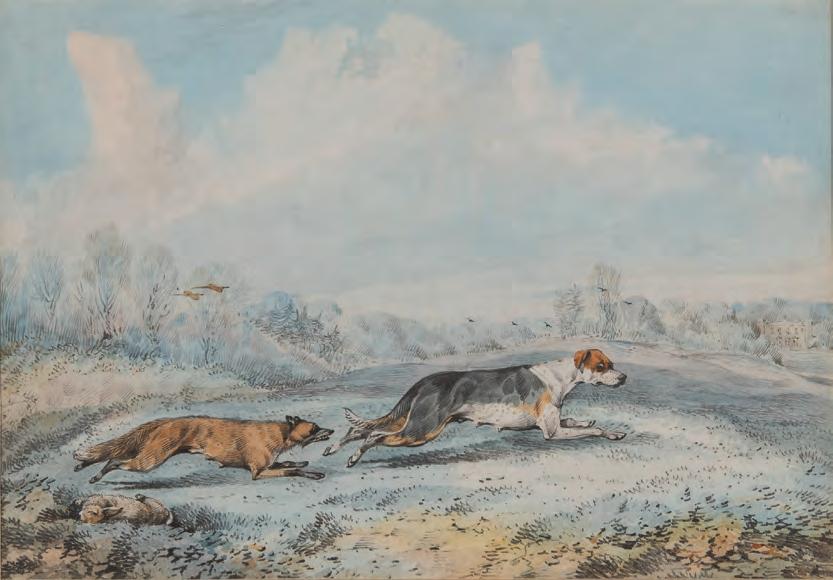
[cat.16]
Henry Thomas Alken (1785-1851)
Fox Hunting - the Tables Turned
Watercolour and pencil
26.3 by 37.8 cm, 10 ¼ by 14 ¾ in.
Provenance: With the Owen Edgar Gallery, Belgravia, London; The Estate of Ilonka Stein, from which acquired, 2024
Henry Thomas Alken was the best known of a family of artists, most of whom specialised in hunting or racing subjects.

[cat.17a]
Sir Edwin Henry Landseer, R.A. (1802-1873)
Pencil
15.5 by 22.6 cm, 6 by 8 ¾ in.
Provenance: The Artist’s studio sale, Christie’s, 8-15 May 1874, bt. Lewis; Charles Mansel Lewis (18451931); By descent until sold at Sotheby’s, 6th July 2010, lot 231, 1 of 2
These two drawings were part of a group bought by Charles Mansel Lewis at Landseer’s studio sale at Christie’s in May 1874. A Welsh landowner and amateur artist Lewis inherited the estate of Stradey in South Wales in 1874. He was a friend and patron of the artist William Rivière and his son Briton as well as Hubert von Herkomer.

[cat.17b]
Sir Edwin Henry Landseer R.A. (1802-1873)
With a study of Herons verso Pencil
21.2 by 28.3 cm, 8 ¼ by 11 in.
Provenance: The Artist’s studio sale, Christie’s, 8-15 May 1874, bt. Lewis; Charles Mansel Lewis (1845-1931); By descent until sold at Sotheby’s, 6th July 2010, lot 230, 1 of 2
This may be a study for Landseer’s oil painting ‘Two Pointers in a Turnip Field’ (Private Collection) exhibited at the Royal Academy in 1820.

[cat.18a]
William Callow, R.W.S. (1812-1908)
Worcester Cathedral from the banks of the river Severn
Watercolour over pencil
Sheet 34.2 by 47.5 cm, 13 ½ by 18 ¾ in.
Provenance: Anonymous sale, Phillip’s, 13th July 1992, lot 45
This is likely to date from Callow’s visit to Tewkesbury, Worcester and Hereford in the autumn of 1848. A watercolour study by Callow dated 1848 of Worcester Cathedral taken from the north is in the V. & A. collection (E.3953-1919).

[cat.18b]
William Callow, R.W.S. (1812-1908)
Richmond Castle from above the river Swale, Yorkshire
Signed, dated and inscribed, lower left: Richmond/Sept. 20 58. Wm Callow
Watercolour over pencil
25.4 by 35.7 cm, 10 by 14 in.
Provenance: Manning Gallery, London
This on-the-spot sketch dates from 20th September 1858. After visiting Leeds, Callow records in his journal: ‘Afterwards we paid to a visit to friends in Lincolnshire, and later proceeded to Richmond in Yorkshire, where we greatly enjoyed some exquisite drives in the neighbourhood. Lady Zetland, on learning that I was staying near by, invited me to Aske Hall, where I received a commission from her for several drawings’ (see William Callow –an Autobiography, edited by H.M. Cundall, 1908, p.115).
A finished watercolour of this view by Callow is in Bradford Art Gallery and another was sold at Christie’s South Kensington on 8th December 2011, lot 427.

[cat.19a]
William Callow, R.W.S. (1812-1908)
Newstead Abbey, Nottinghamshire
Watercolour heightened with scratching out 18.4 by 26.3 cm, 7 ½ by 10 ¼ in.
Provenance: With Manning Gallery, London

[cat.19b]
William Callow, R.W.S. (1812-1908)
A view of Windsor Castle and Eton College Chapel from the Thames
Watercolour heightened with scratching out 13.4 by 18.2 cm, 5 ¼ by 7 in.

[cat.20a]
George Arthur Fripp, R.W.S. (1813-1896)
Trebarwith, Cornwall
Signed lower left: George A Fripp and inscribed: Trebarwith. 1864.
Watercolour over pencil 24 by 33.5 cm, 9 ½ by 13 ¼ in.
Trebarwith is an area of North Cornwall two miles south of Tintagel and it has a famous beach. Fripp exhibited three sets of four views of Trebarwith at the Society of Painters in Water-colours in 1864, nos. 27, 113 and 134.

[cat.20b]
George Arthur Fripp, R.W.S. (1813-1896)
Signed lower right: George A. Fripp./1860.
Watercolour over pencil heightened with bodycolour and scratching out 34 by 49.2 cm, 13 ¼ by 19 ¼ in.
Provenance: With Heather Newman; By descent to the present owner
This may be the watercolour exhibited at the Society of Painters in Water-colours in 1861, no.139 as ‘In Glen Erochy, Ben Vracky in the distance.’

[cat.21]
Signed and dated lower right: J. Cristall 1815
Watercolour over pencil heightened with bodycolour
43 by 34 cm, 17 by 13 ¼ in.
Provenance: Anonymous sale, Sotheby’s, 10th July 1980, lot 43, where bought by the father of the present owners
Literature: Robin McInnes, Furthest South, from the Scottish Borders to the Isle of Wight, 2020, ill. fig. 6.13
Exhibited: London, Society of Painters in Water-colours, 1815, no.246
Cristall visited the Isle of Wight shortly after his marriage in the summer of 1812 and exhibited seventeen views of the island between 1813 and 1820. One of his most important patrons, James Vine, owned a house at Niton on the south coast of the Isle of Wight. Binstead is on the north coast between Fishbourne and Ryde.
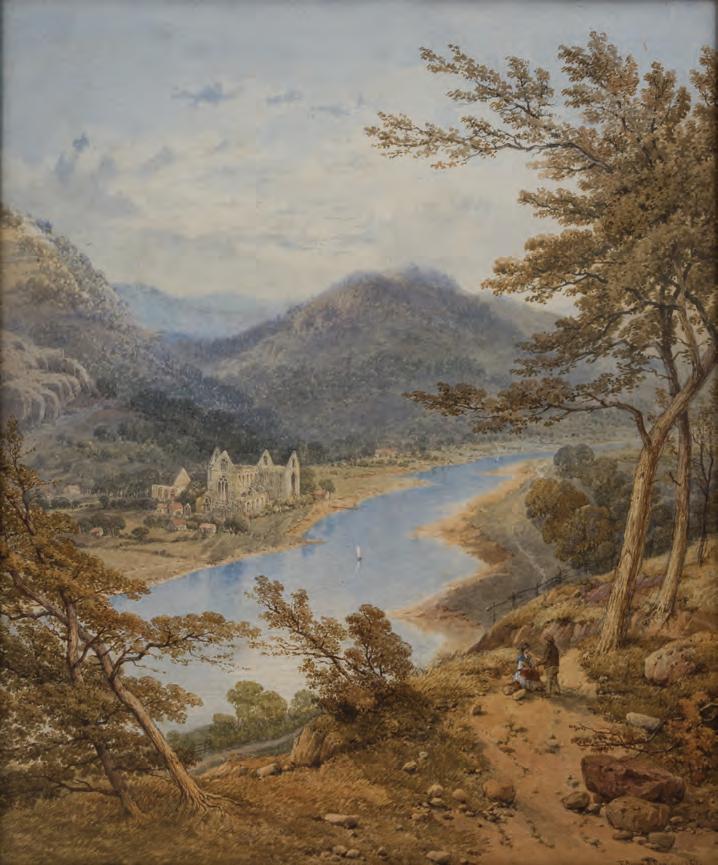
[cat.22]
Tintern Abbey on the river Wye
Signed lower right: Edwin A. Penley. 1873
Watercolour over pencil heightened with touches of bodycolour
45.2 by 37 cm, 17 ¾ by 14 ½ in.
Penley was a self-taught artist who achieved notable success as a drawing master and painter in both watercolour and oils. He travelled widely and achieved Royal patronage, when he was appointed Painter in Watercolour to Queen Adelaide. Queen Victoria sat for a miniature, and he also taught Prince Arthur. The present view shows the ruins of Tintern Abbey on the banks of the River Wye, from the hills on the English side of the border with Wales. The view was probably taken from near the Devil’s Pulpit, where local folklore recorded that the devil sat to tempt the monks in the abbey below.

Signed lower left: from Saint Hospice/Edwd Lear del. Pen and brown ink and watercolour over traces of pencil heightened with bodycolour 13.1 by 35 cm, 5 by 13 ¾ in.
Provenance: Anonymous sale, Sotheby’s, 14th November 1991, lot 175; Private Collection until 2024
The present highly finished watercolour is based on an on-the-spot study begun on 30th November 1864 and completed on 15th January 1865, which was sold at Christie’s on 5th June 2003, lot 154.
Lear decided to spend the winter of 1864-5 on the French Riviera, arriving in Nice on 5th November and spending several weeks sketching and exploring the region. In early December Lear and his manservant Giorgio embarked on a month’s walking tour along the coast to Genoa. They set off on 6th December returning to Nice on New Year’s Eve. Lear’s diary entries for Wednesday 30th November 1864 and Sunday 15th January 1865 record his days in detail. In November he records that the ‘pines are most lovely, & the contrast of their parrot-green with the purple-gray sea & hill, & the sparkly little town below, vastly pretty. Walking to S. Jean, we got to some olives, facing the long Mountain Corniche wall, & there lunched’. Having not finished all the drawings he had begun in November, he ‘resolved then to go & finish all the farthest subjects, so passed … along the narrow path to St. Jean, & beyond to S. Hospice. Here, sheltered partly from an orfle wind lunch. Quirt & pleasant…this, I think hope, is my last visit to this promontory, drawing various times ― the Esa coastline is very grand.’ (Edward Lear diaries, 1858-1888. MS Eng 797.3 (7) and MS Eng 797.3 (8). Houghton Library, Harvard University, Cambridge, Mass.).

[cat.24]
Signed lower left: C. Werner. f. 1864.
Pen and brown ink and watercolour over pencil heightened with bodycolour 48 by 64.6 cm, 18 ¾ by 25 ¼ in.
Provenance: Anonymous sale, Christie’s, 2nd October 1992, lot 94; Anonymous sale, Christie’s, 15th March 1996, lot 132, sold for £16,200; A Princely Collection until 2024
Born in Weimar, Werner studied both painting and architecture before settling on becoming an artist. In 1833, he won a scholarship to travel to Italy, where he remained for nearly twenty years, until the 1850s. A keen watercolourist he paid several visits to England, often for extended periods and between 1860 and 1878, regularly exhibited at the New Watercolour Society.
Werner first visited the Holy Land and Egypt in 1852 and returned a decade later for an extended two year visit to Palestine and Egypt, when he travelled the length of the Nile. The present view depicts Cairo from the south with the Moqattan hills to the left and the mosque of Muhammad Ali in the far centre. The medieval city is visible in the centre of the work. His early training as an architect is evident in the confident manner in which he was able to capture the complex city view before him.

Henry Moore, R.A., R.W.S. (1831-1895)
Signed lower right: Henry Moore 1882
Watercolour over pencil heightened with touches of bodycolour 39.3 by 69.6 cm, 15 ½ by 27 ¼ in.
The son of the landscape painter, William Moore, three of Moore’s siblings were also artists including his younger brother Albert Joseph Moore (18411893). Henry entered the Royal Academy Schools in 1853 and exhibited his first picture that year. As Peter Nahum noted, Moore ‘was one of the first painters to try and observe accurately the movement and moods of the sea’ (Peter Nahum, A Century of Master Drawings, 1995). He had a scientific interest in the form of waves and from the 1870s Moore spent several weeks aboard yachts owned by friends, painting and studying the sea.

[cat.26]
Edward Henry Fahey (1844-1907)
Signed lower left: E.H. FAHEY. 74 Watercolour heightened with bodycolour 36.7 by 26.3 cm, 14 ½ by 10 ¼ in.
Provenance: With Martyn Gregory, July 2003; Christopher Cone, his sale, ‘A Green and Pleasant Land – Two Centuries of British Landscape Paintings’, Sotheby’s, 22nd May 2014, lot 149
Edward Fahey was the son of the portrait and landscape artist James Fahey (1804-1885). He studied architecture before visiting Italy from 1866 to 1869. On his return, he entered the Royal Academy Schools to study painting. He exhibited at the Royal Academy and was a member of the Royal Institute of British Watercolourists from 1872.

Albert Goodwin, R.W.S. (1845-1932)
Pontresina, with the Church of San Niculò, Switzerland
Signed lower right: Albert Goodwin and inscribed and dated lower left: Pontresina July 1913
Pen and black ink and watercolour heightened with bodycolour and scratching out 24.7 by 36 cm, 9 ¾ by 14 ¼ in.
Provenance: With Spink and Son, London; Private Collection until 2024
Pontresina lies in a sheltered south-west position, at a height of 1800m in the Eastern Alps, facing St Moritz, which is just seven kilometres away. Its position at the centre of the Val Bernina, near the Italian border, made it an important village during the Middle Ages and by the mid nineteenth century it had become an key tourist destination.
The present watercolour shows part of the vast mountain range that surround the village, including the highest mountain in the region, the Piz Bernina, which is depicted here, dominating the Church of San Niculò. The steeple with its distinctive onion-shaped octagonal hood was originally located on the Via Maistra and was moved to its present site in 1887.

[cat.28]
Signed lower right: Albert Goodwin, dated 1900 and inscribed lower left: The Lighthouse/Port Said Watercolour heightened with bodycolour and gum arabic with original pen and ink border 17.9 by 28.0 cm, 7 by 11 in.
Provenance: By descent from the artist until 2013
Goodwin travelled extensively throughout his career, following the success of his first trip with his mentor John Ruskin (1819-1900) and fellow artist, Arthur Severn (1842-1931) in 1872. He regularly travelled throughout Europe as well as further afield to Egypt, the West Indies, India, Australia and New Zealand.
The present watercolour shows the dramatic effect of Port Said lighthouse at night, dominating its surroundings and shining out in the night sky. It was designed by the industrialist, experimental builder and engineer François Coignet (1814-1888) at the behest of the Khedive of Egypt and Sudan, Ismail the Magnificent (1830-1899). Along with his grandfather, Muhammad Ali Pasha (1769-1849), they were keen to modernise Egypt and invested heavily in industrial and economic development. Due to the lack of local stone and the cost of bringing suitable materials to site, the Port Said lighthouse was constructed out of the then innovative material, reinforced concrete, for which Coignet became so celebrated. It was completed in 1869, a week before the opening of the Suez Canal, through which it was intended to help guide ships. Due to the build-up of silt, the lighthouse now sits too far inland to be used, however, its importance is reflected in its preservation and its registration in 2011 as a national monument.
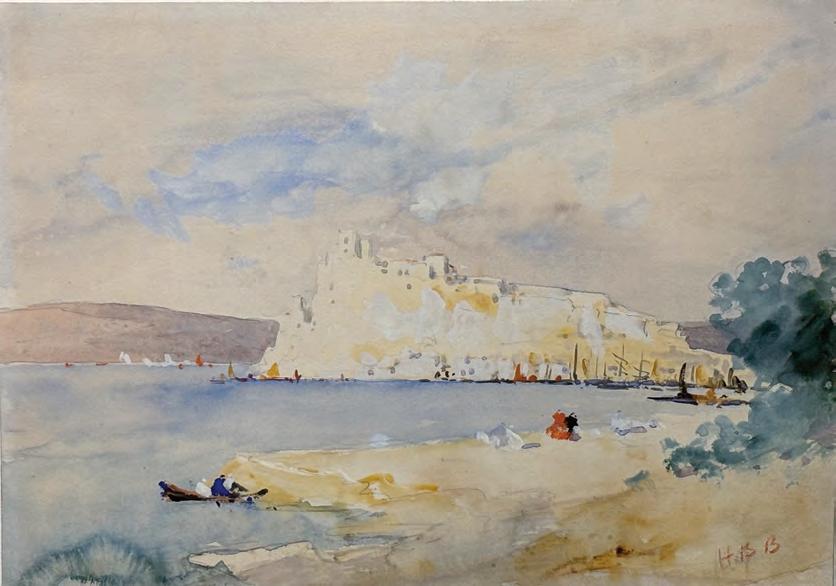
[cat.29]
Hercules Brabazon Brabazon (1821-1906)
Signed with initials lower right and inscribed verso: Ischia near Naples
Watercolour and bodycolour over pencil 19.4 by 27.5 cm, 7 ¾ by 10 ¾ in.
The present watercolour depicts Castello Aragonese, the ancient citadel, built on a small volcanic islet, which has been attached to the main Island of Ischia via a 220m causeway for centuries. Its location on the Gulf of Naples, eighteen nautical miles off the southern Italian coast, and its natural defensive position, meant that it was of strategic importance in the region from the 5th Century BC. Indeed, until a tunnel was built through the rock in the fifteenth century, the only way to access the castle was from the sea, via ladders.

[cat.30]
Signed, inscribed and dated lower left: Perugia J Fullylove 1880
Watercolour over pencil heightened with scratching out 32 by 25.5 cm, 12 ½ by 10 in.
Provenance: Anonymous sale, Phillips 9th June 1986, lot 16, where bought by the present owner
Apprenticed to an architect, Fulleylove is best known for his watercolour views of towns and landscapes in Europe and the Near East, many of which were used as book illustrations.
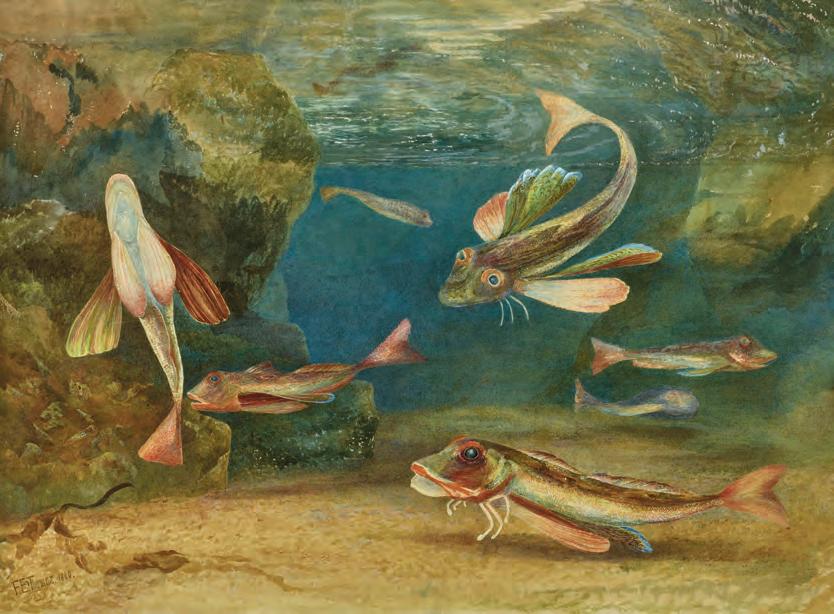
[cat.31a]
Signed and dated lower left: F E Thomas 1880 and signed and inscribed on old label attached to the backboard: Garden of the Nereid…/……/28 Palmeira Square/Brighton and in another hand: Mrs ORLEBAR/Pakyns Manor/Hurstpierpont (3140 tel.) and on a second label: M.rs William Borrer Watercolour heightened with bodycolour and scratching out 41 by 56 cm, 16 ¼ by 22 in.
Provenance: By descent from the artist to Margaret Orlebar née Borrer (1884-1953) of Pakyns Manor, Hurstpierpoint; With Guy Peppiatt Fine Art, 2006; Private Collection until 2023 Exhibited: London, Grosvenor Gallery, 1880
Fanny Thomas was born in St John’s, Newfoundland, Canada in 1851. Her non-appearance in the 1871 UK census suggests she returned to England after that date and in 1880, she exhibited two pictures in London, at the Grosvenor Gallery, as well as a further picture at the Suffolk Street Gallery. In the 1881 census she is recorded as living with her aunt and uncle Sir Richard and Fanny Dacres at 28 Palmeira Square, Brighton together with her two younger sisters Edith and Annie. In early 1883 she married William Borrer (1846-1920) of Pakyns Manor, Hurstpierpoint. She died in Easthampstead, Berkshire in 1925.

[cat.31b]
The Garden of the Nereids, Brighton Aquarium
Signed and dated lower right: F E Thomas 1881 and signed and inscribed on old label attached to the backboard: Gurnards at …/….. in the Brighton Aquarium/Exhibited in the Grosvenor/Gallery 1880/by Miss F.E. Thomas/Naworth Cottage/Shortlands/Kent and in another hand: Mrs ORLEBAR/Pakyns Manor/Hurstpierpont (3140 tel.)
Watercolour heightened with bodycolour and scratching out 41 by 56 cm, 16 ¼ by 22 in.
Provenance: By descent from the artist to Margaret Orlebar née Borrer (1884-1953) of Pakyns Manor, Hurstpierpoint; With Guy Peppiatt Fine Art, 2006; Private Collection until 2023
The Nereids were sea nymphs in the Aegean Sea in Greek mythology.
Brighton Aquarium was one of the earliest in the country. Inspired by the one at Boulogne, it was conceived and designed by Eugenius Birch, the architect responsible for the West Pier. Work began in 1869 and the ornate building, with its pillared and arched interior, initially opened in 1872, its roof terrace opened two years later and shortly afterwards, further attractions including a music conservatory, roller skating rink, smoking room and café. The project cost £133,000 (equivalent to around £5.5 million today). Amongst its early attractions was an octopus, with the first sea lions arriving in 1877.

[cat.32]
Charles Frederick Tunnicliffe, R.A. (1901-1979)
Study of Lapwings in Flight
Pencil
Image 43.6 by 56.8 cm, 17 by 22 ¼ in.
Tunnicliffe is probably the best known British wildlife artist of the second half of the 20th century. Born in Langley, east Cheshire, the son of a shoemaker, he was encouraged to draw by his parents and trained as an artist at Manchester School of Art. Later, in 1921, he was awarded a Royal Exhibition to the Royal College of Art where he specialised in engraving. He first exhibited at the Royal Academy in 1934 and became a Royal Academician in 1954. In 1947, he bought Shorelands, a house on the Cefni estuary at Malltraeth on the south coast of Anglesey, where he lived for the rest of his life.
He exhibited continuously at the Royal Academy from 1938 until 1978, culminating in a major exhibition of his drawings and sketchbooks at the Royal Academy in 1974. In 1954, he was made vice-president of the RSPB and in 1968 of the Society of Wild-Life Artists. In 1975 he was awarded the gold medal of the RSPB and in 1978 he was appointed OBE.
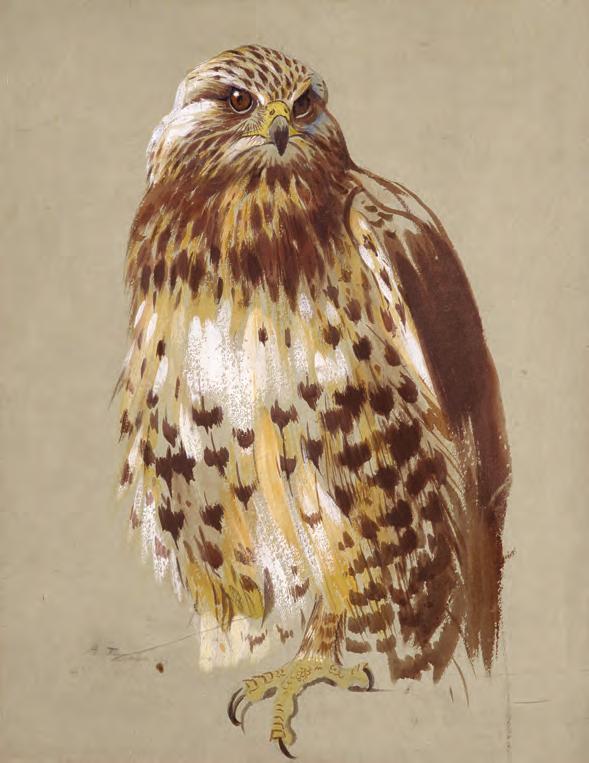
[cat.33]
Archibald Thorburn (1860-1855)
A rough-legged Buzzard
Signed lower left: Archibald Thorburn
Pencil and watercolour heightened with bodycolour on blue-green paper
27.6 by 21.3 cm, 10 ¾ by 8 ½ in.
Provenance: With Spink and Son, London; Private Collection until 2024
Thorburn was born in Scotland, the son of Robert Thorburn (1818-1885), portrait miniaturist to Queen Victoria. He moved to London to study art and in 1887 was commissioned by the artist Joseph Wolf to illustrate Lord Lilford’s Coloured Figures of the Birds of the British Isles, for which he painted 268 watercolours. He soon became the most sought after wildlife artist of the period exhibiting extensively at the Royal Academy and producing illustrations for many books.



of the Harbour at Paxos, Greece
Inscribed and dated l.r.: Paxo (sic)/5 April 1863 and numbered (5) Watercolour over pen and ink 12.5 by 18.5 cm, 5 ½ by 7 ¼ in.
Lear made an extensive tour of the Greek islands in 1863, gathering material for his Views in the Seven Ionian Islands which was published in December of that year. Beginning in Corfu, he continued his tour in the Spring taking in Paxos, Levkas, Ithaca, Cephalonia, Kythera and finally Zante. He arrived at Paxos in early April and made a number of drawings of its harbour. He wrote in his diary for 5th April 1863 (when the present watercolour was painted): “the harbour views of Paxo are remarkable for their quiet bright unity, and for a combination of light and shade which compensates for an absence of beauty in form - architecture … It reminds one of a Cornwall or Devon Cove without its picturesque houses. Great quiet is its characteristic. Its formal new looking houses & rows of windows are hard to do.”

[cat.35]
William Fraser Garden (1856-1921)
A Wooded River Landscape
Watercolour, 27.5 by 38 cm 10 ¾ by 15 in.
It has been suggested that the present watercolour depicts a section of the River Great Ouse at Hemingford Grey in Cambridgeshire. Fraser Garden’s richly coloured landscapes of the Fens largely define him as an artist and are some of the most distinctive images in late Victorian landscape watercolour painting.

[cat.36]
Sir John Everett Millais, Bt. PRA (1829-1896)
Study for a portrait of Louisa, Lady Ashburton and a small dog
Inscribed: Louisa, Lady Ashburton Brush with pen and sepia ink 18 by 11.5 cm, 7 by 4 ½ in.
Provenance: Raoul Millais; from a collection of Millais family drawings acquired through Robert Holden Ltd in 2015
Louisa, Lady Ashburton was one of the most notable female collectors and philanthropists of her generation. As a young woman she studied drawing under John Ruskin, rejecting proposals from both Thomas Carlye and Edwin Landseer. She did not marry Bingham Baring, 2nd Baron Ashburton until 1858 (after he was widowed) and subsequently amassed a significant art collection which included work by Rubens, Mantegna, Rossetti, Edward Lear, George Frederick Watts (who painted her) and Titian. She was romantically involved with the American sculptor Harriet Hosmer who compared her to a goddess writing: “There was the same square-cut and grandiose features, whose classic beauty was humanized by a pair of keen dark eyes.” Later in life she established and gave to a number of charitable causes and institutions including the Ashburton Home of Rest and the Canning Town Mission to Seamen.
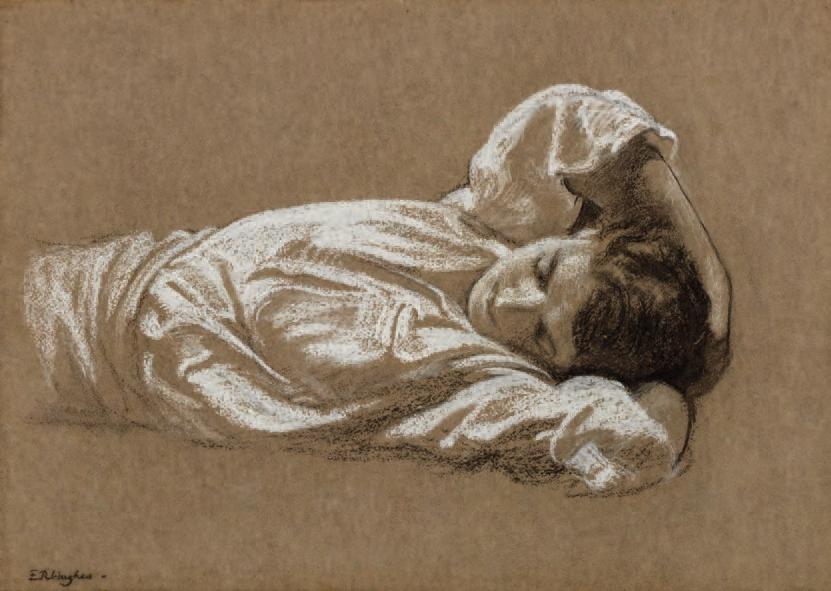
[cat.37]
Signed l.l.: E.R.Hughes
Black and white chalk on brown paper
28 by 37.5 cm, 11 by 14 ¾ in.
Provenance: Christie’s, London, 8 November 1996, lot 37
Hughes was studio assistant to the great Pre-Raphaelite painter William Holman Hunt and an increasingly invaluable figure as Hunt suffered from Glaecoma in the later part of his life. He consequently had a significant hand in several of his master’s great late works including The Light of the World and The Lady of Shalott. His own work is nevertheless extremely distinct and he developed his own style of late Pre Raphaelite painting and drawing which is frequently rich in both fantasy and symbolism. He was nephew of the painter Arthur Hughes, another key figure in the Pre Raphaelite movement.

[cat.38]
Charles Sims, RA, RWS (1873-1928)
Motherhood
Signed l.r.: Charles Sims
Tempera
47 by 66 cm, 18 ½ by 26 in.
This touching evocation of motherhood bears witness to Sims’s talents as a leading Edwardian painter of swagger portraits. Training under Benjamin Constant and Jules Lefebre at the Académie Julian in Paris in the early 1890s he continued his studies at the Royal College of Art where he was a Landseer Scholar. Some of Sims’s work exhibits the same flamboyant, painterly qualities of John Singer Sargent. Sims’s later works embraced mysticism in a series of extraordinary semi-abstract figure works which he executed just prior to his death. He was elected a Royal Academician in 1915 and was later Keeper of the Royal Academy Schools (1920-26).
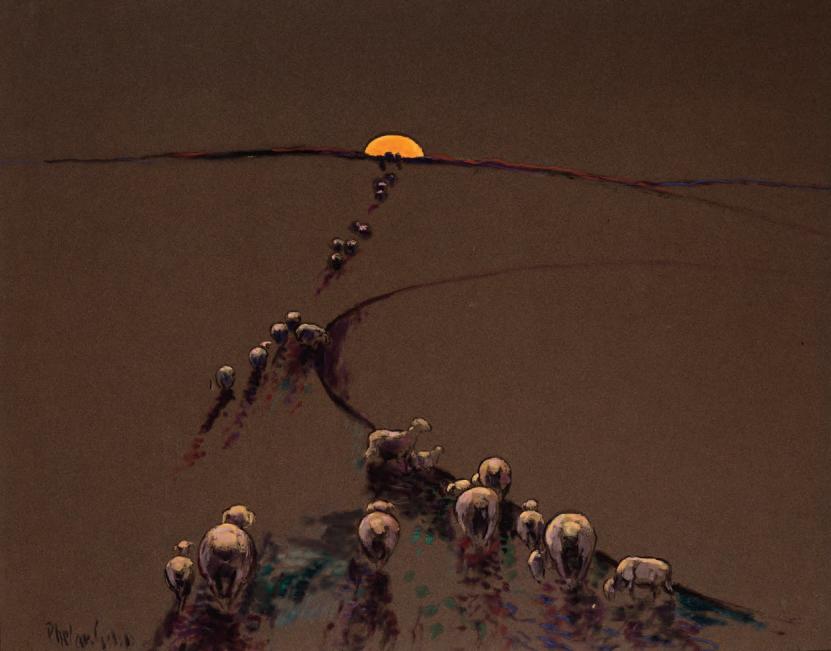
[cat.39]
Signed l.l.: Phelan Gibb
Oil with brush and ink on dark brown paper 56 by 81.25 cm, 22 by 32 in.
The present work captures an intense sunset near the Devon coast at Lynmouth, just by Gibb’s cottage in Brendon. Gibb had his first London show at the Baillie Gallery in 1911 just prior to Roger Fry’s groundbreaking Post Impressionist exhibitions. Having lived and worked for much of his life until that point in Paris, he brought an international style to the British art world which was perfectly in tune with the era. As well as being admired by Fry, he found a particular fan in the great inter-war art dealer Lucy Wertheim who wrote of him: “The English artist still living today whose work probably is of the most permanent value is Phelan Gibb. One day Phelan Gibb will doubtless come into his own, and his finest paintings take their place alongside of examples of Manet, Cezanne, Picasso… in international exhibitions of Modern Art.”

[cat.40a]
Signed l.l.: Pryde Watercolour, gouache, en grisailles
16.5 by 20 cm, 6 ½ by 8 in.
Provenance: the estate of Sir Ralph Richardson; sold Sotheby’s, The Ralph Richardson Collection, 27 April 2001, lot 310 Pryde’s dark, cavernous interiors regularly dwell on themes of ruin and dereliction. The same can be said of his figure subjects, which often depict rejects in society, whether down-and-outs, beggars or criminals. These themes were brought to fruition in the lithographs he executed for the 1907 publication Portraits of Celebrated Criminals. The foundations for these works were clearly laid out in numerous earlier drawings by the artist depicting “celebrated criminals, rascals and beggars”, celebrating in a “Prydian” way outcasts in society. The present work has been known under several titles (including as a portrait of Ralph Richardson (its former owner) performing in a play) and appears to be a study for a work known (possibly not by Pryde himself) as The Untouchables (sold Christie’s, London, Peter Langan: A Life with Art, 18 December 2012, lot 101).

With a further pencil sketch (verso) titled “The Lovers” and other inscriptions
Watercolour with gouache 12 by 7.5 cm, 4 ¾ by 3 in.
Provenance: a gift to a previous owner from Kenneth Clark in May 1943, according to an inscription to the reverse of the original Rowley Gallery backboard
One of a series of illuminating inscriptions on the verso of the present drawing (see illustration below) is possibly a reference to the painter and photographer Malcolm Arbuthnot (apparently a memo by the artist to meet the latter at 12). Arbuthnot was commissioned by the Goupil Gallery to take photographs of a number of leading artists of the era including Pryde, who also exhibited with the gallery.

[cat.41]
Walter Sickert, RA (1860-1943)
Study for “La Carolina: Venetian Girl Seated on a Sofa”, c.1903-4
Pen and black ink over pencil 16 by 14 cm, 6 ¼ by 5 ½ in.
This drawing is a study for a painting with the same title now in the collection of Stanford University, USA (see fig.1 alongside (Iris & B.Gerald Cantor Center for Visual Arts)) (see, Wendy Baron, Sickert: Paintings and Drawings, Yale, 2006, p.282, no.193). The sitter is one of Sickert’s most regular Venetian sitters, Carolina Dell’Acqua (usually rendered by Sickert as Caroline Dell’Aqua) and reputedly nicknamed this way due to her aversion to water. Sickert’s distinctive technique of intense cross-hatching in pen and ink over a pencil background helps convey something of the artist’s shadowy impressionist style, so central to his paintings from the date.
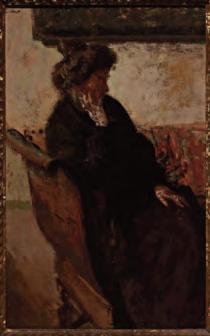

[cat.42]
Signed u.r.: Eric Robertson
Pencil, 23.5 by 49.5 cm, 9 ¼ by 19 ½ in.
Provenance: acquired by the previous owner from the Maas Gallery
Robertson was a highly gifted Edinburgh painter whose work assimilated the influences of both late Pre-Raphaelite and European Symbolist art, including that of the French painter Gustave Moreau and the Scottish artist John Duncan. He is most famous for his suggestive nude compositions many of which caused scandal in Edinburgh in that era. The present drawing (a study for the 1911 painting “Desire”) is a strong example.

[cat.43]
Jack Butler Yeats (1871-1957)
The Fisherman
Watercolour over pen and black ink 19 by 24 cm, 7 ½ by 9 ½ in.
The present work is typical of Yeats’s early watercolours, which adopt a distinctive illustrative style conjuring up a Romanticised version of the landscape and people of Sligo where he had been brought up as a child. Yeats, who was the son of the Irish portrait painter John Butler Yeats, was six years younger than his brother, the great Irish writer, W.B.Yeats.

[cat.44]
Pencil
20 by 15 cm, 8 by 6 in.
Provenance: acquired by the present owner from Paul Liss
The picturesque hilltop village of Anticoli Corrado, some forty kilometres from Rome, has provided a natural retreat for artists throughout history. A group of painters that particularly claimed the village as their own were the winners of the prestigious Rome Scholarship in Decorative Painting, which was awarded to a British artist each year from 1919. Many of these artists took their impulse from the village’s architecture and its ideal setting for the kind of Piero della Francesca-influenced Allegorical scenes favoured by the Rome School artists. Knights became the first woman to win the scholarship in 1920 and moved to Anticoli Corrado with her fellow painter Arnold Mason following their engagement that year.

[cat.45a]
Watercolour over pen and ink and traces of pencil 28.5 by 34.5 cm, 11 ¼ by 13 ½ in.
Literature: W. Shakespeare, The Tragedie of King Lear; Newly Published from the First Folio of 1623, Ernest Benn Ltd, London, 1927, illustrated as a colour plate; Brian Webb & Peyton Skipwith, Paul Nash/John Nash Design, Antique Collectors’ Club, 2006, p.35 (for illustrations of two other colour plates from the edition)
The present work is the original watercolour for one of five published colour plates that Paul Nash produced for a 1927 Ernest Benn edition of King Lear. The watercolour is a visualization of Act 1, Scene 1 of the play and was reproduced as a full page opposite text from the scene. Nash’s illustrations for King Lear are widely considered to be a high point in his work as a book illustrator, the Nash scholar Andrew Causey observing: “In his designs for King Lear…Nash had captured something of this superhuman scale by restricting himself to compositions of great simplicity in which the formalized figures were all but crushed by the weight of the empty space around them…King Lear was an outstanding production…among work in the mid-twenties”. (Andrew Causey, Paul Nash, Clarendon Press, 1980, p.167)

Signed with monogram l.l.: PN
Coloured crayon with soft pencil 9 by 13 cm, 3 ½ by 5 ¼ in.
Provenance: from the artist to the Curwen Press; Oliver Simon, director of the Curwen Press; Stanley Jones
Literature: Andrew Causey, Paul Nash, Clarendon Press, 1980, see under nos.752-763 (p.422)
Nash’s visionary depiction of The Nest of the Phoenix is one of his finest works from the later 1930s (see fig.2). Its conception, however, occurred far earlier as part of his illustrations for an edition of Sir Thomas Browne’s Urne Buriall and the Garden of Cyrus. That is now generally considered to be his most important work as a book illustrator and was published by the Curwen Press in 1932. The present drawing was originally in the collection of Nash’s great friend (and director and typographer of the Curwen Press) Oliver Simon. It is almost certainly one of the few surviving small pencil and crayon illustrations, made by Nash to help the Curwen artists realise his ambition for the project. Although small in scale, this drawing’s vivid and intense portrayal of the immortal regenerating bird of the title (one so central to ancient mythology), gets to the heart of Nash’s visionary status within British art and looks forward to his sometimes apocalyptic paintings from the early 1940s. Fig.2


John Nash, RA (1893-1977)
Signed with initials l.l.: JN and inscribed with title Pen and black ink
37 by 27.5 cm, 14 ½ by 10 ¾ in.
Literature: Jason Hill, Natural History and Morality of the Aspidistra, The Listener, 29 August, 1934, p.370 (illustration for the article); Jason Hill, The Contemplative Gardener, Faber & Faber, 1940, illustrated facing p.202

[cat.46]
Edward Ardizzone, RA (1900-1979)
An Artist with his Model
Signed with initials in pencil l.r: EA
Red chalk
21.5 by 26.5 cm, 8 ½ by 10 ½ in.
Provenance: acquired by the previous owner from Chris Beetles in 1987

[cat.47]
Sir Stanley Spencer, RA (1891-1959)
Study for “The Music Lesson, Bedales”, 1921
Verso: a further related study in pencil
Watercolour over pencil
39.5 by 60 cm, 15 ½ by 23 ½ in.
Provenance: with the Piccadilly Gallery, London
Between 1919 and 1920 Spencer lived with the judge Sir Henry Slesser and his wife Margaret, a stay that resulted in a series of remarkable commissions that would culminate in his masterpiece The Resurrection, Cookham of 1924-7. At around the same period Spencer also embarked on a number of other significant projects, one of which took him to the progressive Bedales School near Petersfield in Hampshire. Here he stayed with his fellow artist Muirhead Bone and began to sketch ideas for an ultimately unrealised scheme for the school’s memorial hall. A number of studies exist for this of which the present work is amongst the strongest. A closely related painting also resulted from the project which was sold by Spencer’s dealers Arthur Tooth in 1960.

[cat.48]
Horace Mann Livens (1862-1940)
Horse Drawn Carriage by Bond Street Underground Station
Signed and dated l.l.: H.M.Livens/20
Watercolour over pencil on brown paper
29 by 25 cm, 11 ½ by 10 in.
Today Livens is principally known for his friendship with Vincent van Gogh who he met whilst working under Charles Verlat at the Académie Royale des Beaux-Arts in Antwerp. Van Gogh later wrote to Livens “I liked your colour, your ideas on art and literature and I add, most of all your personality…that neither your colour nor mine as it is developing itself, is exactly the same as their theories”. He excelled at London street scenes like this, providing illustrations for E. V. Lucas’s London Revisited in 1916.

[cat.49]
Indistinctly inscribed l.r.
Pen and dark brown ink
23 by 21 cm, 9 by 8 ¼ in.
Provenance: with Rothman’s of Pall Mall in 1960
Literature: Laurence Whistler & Ronald Fuller, The Work of Rex Whistler, Batsford, London, 1960 (under no.650)
In 1940 Rothman’s of Pall Mall began commissioning drawings from Whistler “as a policy of keeping their name before the public until the normal market should be restored” (Laurence Whistler, op cit). Their contents read as a humorous survey of smoking in history and literature. Several were later used for a 1950 publication to celebrate sixty years of Rothman’s.

[cat.50]
Barbara Jones (1912-1978)
Waxworks at Madame Tussaud’s for “The Unsophisticated Arts”, 1951
Titled, annotated and with the artist’s studio stamp (verso)
Watercolour
35 by 26 cm, 13 ¾ by 10 ¼ in.
Literature: Barbara Jones, The Unsophisticated Arts, 1951, p.119; Ruth Artmonsky, A Snapper Up of Unconsidered Trifles – A Tribute to Barbara Jones, Artmonsky Arts, 2008, no.A2
The present work is illustrated in black and white in Jones’s landmark 1951 book The Unsophisticated Arts – her highly influential exploration of popular everyday and vernacular arts in Britain. In her depiction of waxworks in London’s Madame Tussaud’s she shows four figures from Western Christianity: John Calvin, William Knox, William of Wykeham.

[cat.51a]
Signed l.l.: Ethelbert White
Watercolour
33.5 by 42.5 cm, 13 ¼ by 16 ¾ in.
White’s landscape pictures of the 1920s are some of the most instantly recognisable of the period. One of the leading printmakers of the time (he was a founder-member of the English Wood Engraving Society in 1925), such works are remarkable in their ability to imbue everyday subjects with an unusual sense of poetry and lyricism. Peyton Skipwith has appropriately described him as “a draughtsman with an engraver’s eye”. These two watercolours are both good examples of his fine 1920s style.

[cat.51b]
Ethelbert White, RWS (1891-1972)
Landscape with Rolling Hills
Signed l.l.: Ethelbert White
Watercolour
28.5 by 23 cm, 11 ¼ by 9 in.

[cat.52a]
Sir Cecil Beaton (1903-1980)
Dressmakers at Hattie Carnegie’s
Signed l.r.: Beaton Wash over pen and ink 43 by 29 cm, 17 by 11 ¼ in.
Exhibited: Michael Parkin Fine Art, Cecil Beaton Memorial Exhibition, 1983, no.110
Literature: Josephine Ross, Cecil Beaton in Vogue, Thames & Hudson, 1986, p.153 (illustrated)
The present illustration was executed for Vogue, on 1st November 1932. Hattie Carnegie, born in Austria as Henrietta Kanengeiser in 1886 was one of the leading New York fashion entrepreneurs of the early part of the twentieth century. Carnegie’s business had reached its height in the 1920s and early 1930s, buying a building off Park Avenue on 42 East 49th Street and boasting sales of $3.5 million in 1929. The business weathered the Great Depression creating a less expensive clothing line called Spectator Sports. Beaton frequently photographed for Hattie Carnegie from the 1930s through to the 1950s. With characteristic Beaton humour, the artist has conjured up the world of the unseen side of the Hattie Carnegie business, observing with a loving attention to detail the hard working dressmakers behind the scenes.
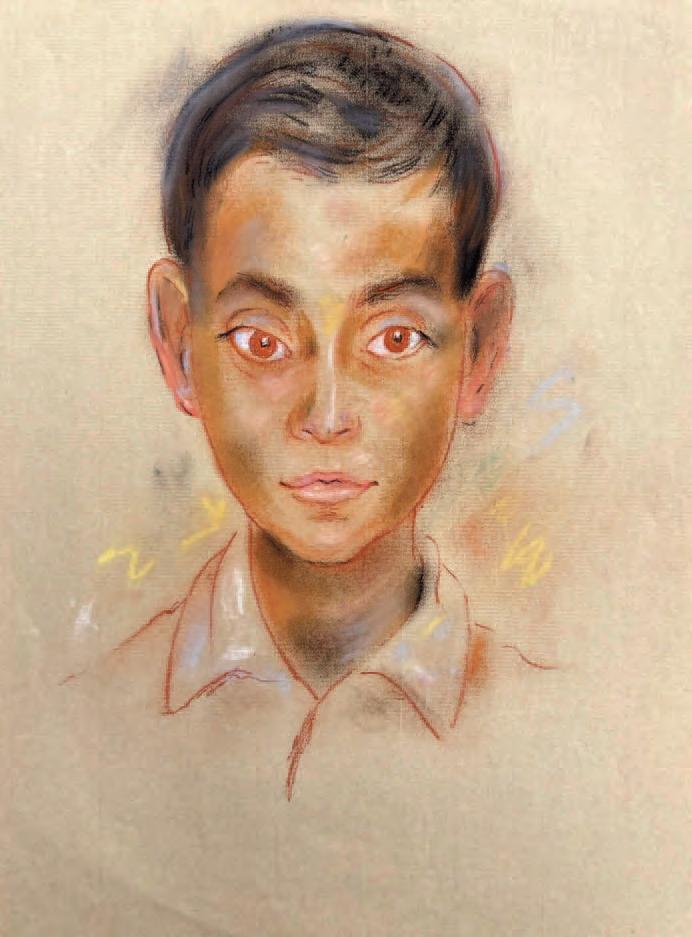
[cat.52b]
Sir Cecil Beaton (1903-1980)
Portrait of a Boy, c.1952
Coloured chalks, 29 by 22 cm, 11 ¼ by 8 ¾ in.
Provenance: The Cecil Beaton Studio Sale, Christie’s, South Kensington, 21st June 1989, lot.164 (part)
This sensitive pastel was originally contained within a drawing pad that included Beaton’s set and costume designs for the 1952 ballet Picnic in Tintagel. A Frederick Ashton production for New York City Ballet, this work incorporated music by Arnold Bax (including his eponymous tone poem, Tintagel). It is not known whether the sitter here relates to the production.

[cat.53]
Jacob Kramer (1892-1962)
Seated Woman, c.1917
Signed u.r.: Kramer
Gouache with brush, pen and indian ink 25 by 18.5 cm, 9 ¾ by 7 ¼ in.
Kramer entered the Slade School of Art in 1913, just a year prior to the outbreak of War. During his time here he met many auspicious figures in British art of the period including David Bomberg, Mark Gertler and William Roberts (Kramer’s sister Sarah would later marry Roberts). Although he refused to be pinned down to a particular artistic movement, he joined the London Group in 1915 through which he was invited to show with the Vorticists. Kramer’s work of the 1910s bears the closest comparison with the work of this movement, such as in dynamic works like this which employ a strongly graphic (almost abstracted) twocolour composition. This style also lent itself well to contemporary illustration, with several of Kramer’s woodcuts appearing in the Vorticists’ literary magazine Blast

[cat.54]
Signed with the artist's studio stamp
Watercolour over pencil
38 by 65 cm, 15 by 25 ½ in.
Provenance: acquired by the previous owner from Marina Henderson Gallery, London c.1986
This characteristically menacing figure group is a design for a production of Carmen at the Royal Opera House Covent Garden in 1947. Burra made a notable contribution to set and costume design for British theatre (and in particular ballet and opera) which are frequently highly lavish and colourful. They include those for Constant Lambert's ballet the Rio Grande in the 1930s.

Sir Matthew Smith (1879-1959)
Still Life with Dahlias in a Jug
Signed with initials l.l.: MS
Watercolour with gouache 29 by 29 cm, 11 ¼ by 11 ¼ in.

[cat.55b]
Sir Jacob Epstein (1880-1959) Clematis
Signed l.l.: Epstein
Gouache and pencil on paper
55 by 43 cm, 21 ½ by 17 in.
Provenance: with the Leicester Galleries
Flower paintings by Epstein generally date from the 1930s when a firm of Dutch art dealers commissioned a series from him. Exhibitions dedicated to the subject followed at Arthur Tooth and the Redfern Gallery in the early 1930s. He later wrote in his autobiography Let There be Sculpture “I said I would paint twenty and, in the end, I painted sixty, giving up sculpture for the time being…I lived and painted flowers”.

[cat.56]
Henry Moore, OM, CH (1898-1986)
Tree Form
Signed and dated l.l.: Moore/81
Black chalk with chinagraph pencil on white paper
35.5 by 25.5 cm, 14 by 10 in.
Literature: Ann Garrould, Henry Moore: Complete Drawings, 1977-1981, London 1994, vol. 5, no. AG 81.326, p. 234, illustrated
“I have always had a great liking for trees, and for tree trunks in particular. I like the bare trees in winter more perhaps than summer trees in full leaf. The trunks of trees have, for me, a connection with the human body – their limbs branch out like arms and legs from the trunk of a figure. For me, too, trees have a definite affinity with sculpture. The immobility of a tree, rooted in the ground, has the kind of stability that I like in sculpture.” Henry Moore writing in 1979 (Henry Moore: Drawings 1969-79 Wildenstein, New York (14 November 1979 – 18 January 1980) p.18)

[cat.57]
Lucian Freud, OM, CH (1922-2011)
Pen and black ink
25 by 18 cm, 9 ¾ by 7 in.
Provenance: James Kirkman (Lucian Freud’s agent); from whom acquired by the previous owner, Raymond Hall, friend and model of Lucian Freud
A comparable but more finished drawing of a castor oil plant was exhibited at the Arts Council of Great Britain’s 1974 Lucian Freud retrospective (no.34). That work was dated by the artist to 1946. Some of Freud’s work in that year was painted on the Greek island of Poros, possibly including the present drawing. Freud’s drawings from the mid-1940s are now considered to be amongst the finest works on paper by any British artist working in the mid twentieth century.

[cat.58a]
Keith Vaughan (1912-1977)
Inscribed with Christmas and New Year greetings from the artist (to inner section of card)
Collage laid to card 18 by 12 cm, 7 by 4 ¾ in.
Provenance: Klaus Peter Adam (a friend of the artist)
Collages by Keith Vaughan are rare. The present example was a gift to the artist’s friend Klaus Peter Adam. It was probably executed in the early to mid 1970s.

Signed and dated l.r.: KV/1959 and inscribed with title c.r.: Iowa City/Des Moines with further signature and inscription in the artist’s hand on the original label (to reverse of board)
Two pencil drawings assembled as a collage over wash and ink
30 by 25 cm, 12 by 9 ¾ in.
Provenance: Agnew’s, New Bond Street
Vaughan was a visiting teacher at Iowa State University for one term in the Winter and Spring of 1959. Whilst there he painted some brooding landscapes and cityscapes capturing something of the bleakness of a mid-American winter. This unusual drawing/collage incorporates two delicate wintry landscapes of typical Iowan farmsteads.

Signed l.r.: John Piper Watercolour with gouache 54 by 104 cm, 21 ¼ by 41 in.
Provenance: acquired by the previous owners from Marlborough Fine Art in 1975
John Piper’s sets for Benjamin Britten’s last opera Death in Venice represent the summit of his career as a designer for the theatre and of his long association with the English Opera Group of which he had been a co-founder. First performed at Aldeburgh in June 1973, the composer was by then too unwell to conduct the piece himself. The Piper family’s association with the work is a strong one, with the artist’s wife Myfanwy writing the opera’s English libretto. For her too it was a culmination of a series of highly successful collaborations with Britten as his favoured librettist.
Britten’s setting of Thomas Mann’s novella is one the composer’s sparsest scores, strongly reflected in Piper’s memorable sets, including the dark canalscapes and empty, receding beach, the subject of the present watercolour. This design would become the fitting background for the work’s protagonist, Gustav von Aschenbach, as he admires the captivating beauty of the boy Tadzio, before finally falling victim to a deadly plague at the end of the opera.
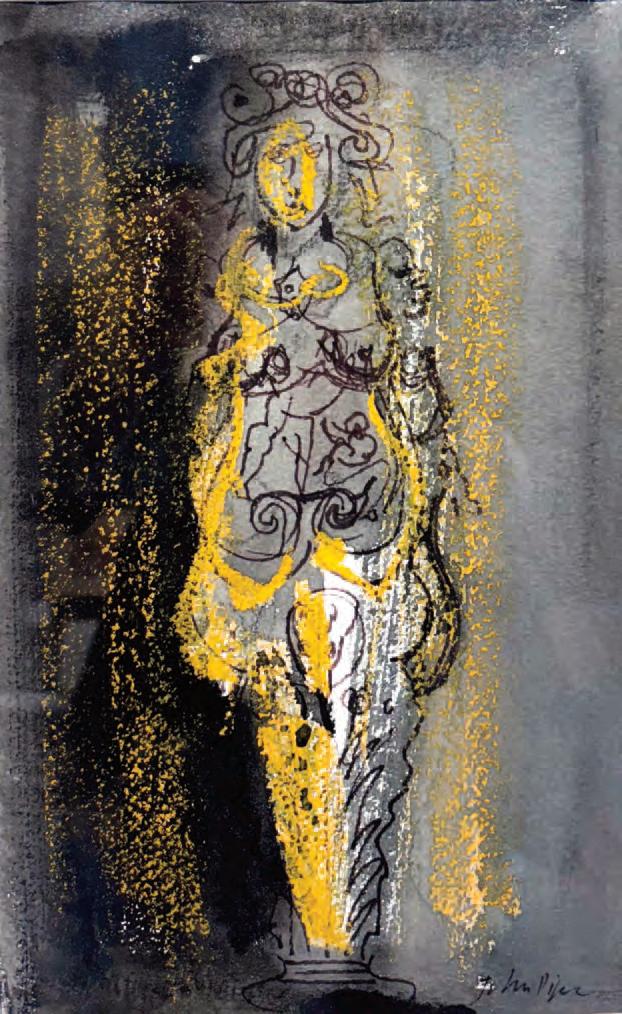
[cat.59b]
John Piper, CH (1903-1992)
Study of a Medieval Carving
Signed l.r.: John Piper
Watercolour with wax resist over pen and ink
27.5 by 15.5 cm, 10 ¾ by 6 in.

[cat.60a]
Graham Sutherland, OM (1903-1980)
Apple Orchard Trottiscliffe, 1943
Signed and dated u.r.: Sutherland/1943
Pen with wash and Indian ink, chalk, pencil and gouache
22.5 by 16.5 cm, 9 by 6 ½ in.
Provenance: Private Collection, Milan
The apple trees in Sutherland’s orchard at his home in Trottiscliffe in Kent were a regular subject for the artist in the early 1940s (falling as vital respite in between his gruelling work as a War Artist in London and Wales). For a related study to this drawing see Rosalind Thuillier, Graham Sutherland, Life, Work and Ideas, Lutterworth Press, 2015, p.88.

[cat.60b]
Graham Sutherland, OM (1903-1980)
Estuary Landscape with Setting Sun
With a further study (verso)
Watercolour over pen and ink and touches of pencil on two joined sheets of paper
22 by 34.5 cm, 8 ½ by 13 ½ in.
Provenance: Goldmark Gallery, Rutland; originally a page from one of the artist’s Pembrokeshire sketchbooks of the early 1970s
Painted on one of Sutherland’s return trips to the estuaries and landscapes off the Pembrokeshire coast in the early 1970s.

[cat.61]
Roland Collins (1918-2015)
Fishermen’s Barrells on Newhaven Harbour
Watercolour, 37 by 52.5 cm, 14 ½ by 20 ¾ in.
Provenance: Michael Parkin

[cat.62]
The Ocean Floor of the Red Sea
Signed l.r.: R.Gibbings
Pencil on xylonite sheet with hand-colouring in crayon 30 by 20.5 cm, 12 by 8 in.
Gibbings, a central figure in the British wood-engraving revival of the early twentieth century, also has a claim to be one of the first artists to attempt drawing under water. By the 1930s Gibbings had developed an extensive knowledge of marine life and became dissatisfied with merely making observational drawings or engravings from dead specimens or photographic sources. He wrote in 1938 “… it was my ambition to get on closer terms with the fish, and to meet them on their own level … to make drawings under the water.” To achieve this Gibbings alighted on a material called xylonite, a celluloid-like material which (unlike paper) was waterproof. The present work is one such example, the pencil drawing made under water with later hand-colouring to further convey the experience of the scene. Published in his landmark book Blue Angels and Whales (1938) the present work has the following caption under the illustration: “The central clump of coral was ten feet high and yellow, the low shrubby growth in the foreground coloured…the fish metallic gold and mauve.”

[cat.63]
Signed l.r.: Peter White
Watercolour over pen and ink
31 by 46 cm, 12 ¼ by 18 in.
Exhibited: Royal Watercolour Society, London, Britain in Watercolours, 1953
White was part of the community of painters at Great Bardfield, where he was a printing assistant to both Michael Rothenstein and Edward Bawden. Malcolm Yorke notes “when work was slack there (with Michael Rothenstein) he crossed the road to help Bawden” (Malcolm Yorke, Edward Bawden and his Circle, Fleece Press, 2005, p.186). White assisted Bawden on his great linocuts of Liverpool Street Station and Brighton Pier as well as on mural schemes. He later taught art in Braintree and in Colchester becoming a notable figure in Essex artistic life. This fine landscape shows White’s own take on English landscape painting of the period, assimilating the influences of artists like his namesake Ethelbert White and his Essex-based neighbour John Nash.

[cat.64]
Claude Rogers (1907-1979)
View from the Wing of a British European Airways Jet, c.1970
With indistinct inscription (l.r.)
Colour chalks with watercolour
29 by 34.5 cm, 11 ½ by 13 ½ in.
Rogers became fascinated with painting from commercial airlines in the early 1970s, at around the time aeroplane travel was becoming more widely available. As well as views from the cabins and cockpits of aeroplanes are some fine views of cities by night, taken from sketches made on approaches to commercial airports.

[cat.65a]
Robert Tavener, RE (1920-2004)
Sussex Barns
Signed l.r.: Robert Tavener
Watercolour over pen and ink
42 by 50 cm, 16 ½ by 19 ¾ in.

[cat.65b]
Robert Tavener, RE (1920-2004)
Autumn Landscape on the Downs near Lewes
Signed l.r.: Robert Tavener
Watercolour over pen and ink
40 by 57 cm, 15 ¾ by 22 ½ in.
Tavener moved to East Sussex in 1953 to take up the post of head of the Printmaking at Eastbourne School of Art. Much of his work in the following decades focused on the Sussex landscape, including the South Downs and the distinctive architecture and flora and fauna of area. He also worked as a commercial artist, creating work for Shell, London Transport, the BBC and Radio Times. In 1958 he illustrated the diary for the Kynoch Press, following in the footsteps of his fellow Eastbourne artist, Eric Ravilious, who also remained a lasting inspiration for Tavener’s work on paper. A major retrospective of his work as a printmaker Robert Tavener Shape Pattern Colour: The Art of Printmaking recently closed at the Towner Art Gallery in Eastbourne.

[cat.66a]
Signed l.r.: David Gentleman
Watercolour, 39 by 55 cm, 15 ¼ by 21 ½ in.
Exhibited: David Gentleman at Eighty, Fine Art Society, New Bond Street, March-April 2010, no.43
Gentleman’s early work from the 1950s is very rare and shows something of the influence of Bawden and John Nash who had taught him at the Royal College of Art, as well as a stylised rendering of the patterns of landscape that is reminiscent of his early work in linocut. Mistley is on an estuary on the Essex/Suffolk border on the banks of the river Stour a few miles downstream from Constable country.

[cat.66b]
David Gentleman (born 1930)
The City of London from Bankside
Signed l.r.: David Gentleman
Watercolour over pen and ink
49.5 by 63.5 cm, 19 ½ by 25 in.
Provenance: acquired by the present owner from the Mercury Gallery in October 2000
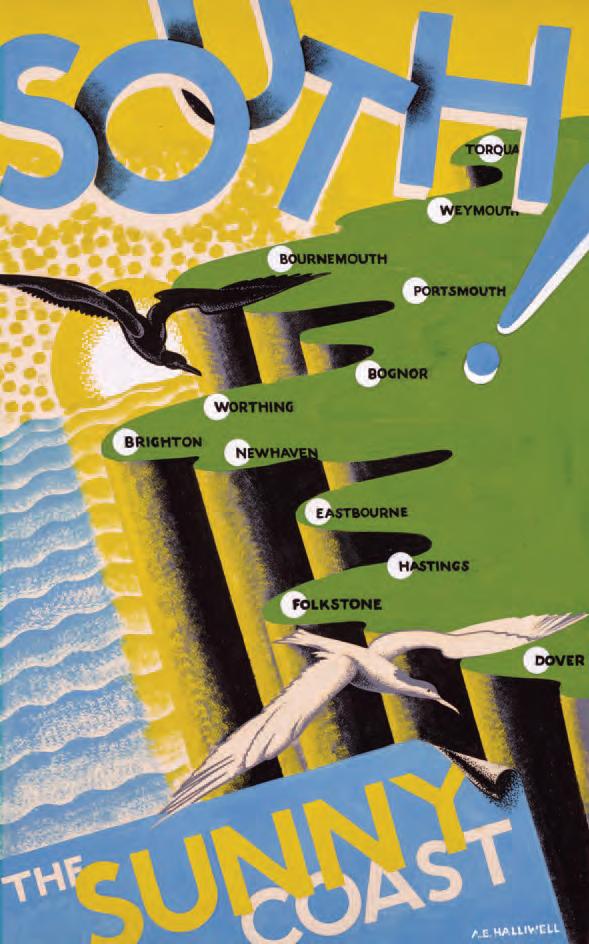
[cat.67a]
Albert Edward Halliwell (1905-1987)
South - The Sunny Coast
Design for a Southern Railway Poster, c.late 1920s
Gouache
52 by 32 cm, 20 ½ by 12 ½ in.
Halliwell, who studied at Stockport School of Art and the Royal College of Art is at his best in the commercial artwork he created in the 1920s which is amongst the best of the English Art Deco. As well as posters for London Transport, Southern Electric and Imperial and International Communications he made packaging design for firms such as Bird’s Custard and Melias Coffee. Latterly he was an influential teacher in the field of commercial design at both Camberwell and Central School of Arts and Crafts.

[cat.67b]
Flight
Signed under mount and dated (1929) Gouache
23 by 46 cm, 9 by 18 in.
The present work relates to the poster Book to Colindale, printed by the Baynard Press in 1929 for the Underground Electric Railways Company Ltd and probably Albert Halliwell’s most successful work as a poster designer (see fig.3). Albert and his wife Doris collaborated on many projects at the time, apparently sometimes working under the pseudonym “Haldo” which incorporated both their names. The dynamic gouaches of aeroplanes in flight by both artists (as well as the final poster) hint at the abstract quality of the movement of flight in a composition that perfectly suits the final medium of printed commercial design.
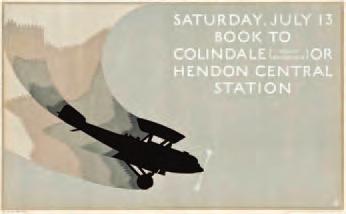



[cat.68]
Seated Nude
Signed and dated ‘38
Red chalk
35 by 25 cm, 13 ¾ by 9 ¾ in.
Provenance: Thos. Agnew & Sons Ltd, London
Frank Dobson was a sculptor, draughtsman and painter in oil and watercolour. Born in London, the son of an artist with whom he initially studied, Dobson first attended Leyton School of Art, 1900-2, was an apprentice studio boy with the sculptor Sir William Reynolds-Stephens, 1902-4. After a time in Cornwall was, 1906-10, at Hospitalfield Art Institute, Arbroath, finally attending the City and Guilds School, Kennington, 1910-12. Although he made his first wood-carving just before World War I, of Dobson’s first one-man show, at the Chenil Galleries, 1914, was of paintings and drawings. During World War he enlisted in Artists’ Rifles and continued working, Imperial War Museum acquiring his large oil The Balloon Apron After the war Dobson met Wyndham Lewis and exhibited with Group X in 1920; had a first one-man show as a sculptor at Leicester Galleries, 1921. First sculptures were very stylised, but later work influenced by the work of Aristide Maillol. During the inter-war years Dobson consolidated his reputation - with Epstein he was called “a keeper of tradition”, bridging classical and modern sculpture.
Official War Artist in World War II. Professor of sculpture at the Royal College of Art, 1946-53. Elected RA, 1953. Dobson is represented in many public galleries, including the Tate Gallery. Arts Council memorial exhibition 1966, and touring; retrospective Kettle’s Yard, Cambridge, 1981-2, toured; major reappraisal at Henry Moore Institute, Leeds, 1994. The Fine Art Society exhibited The Trask Bequest, works by Paul Nash and Dobson, in 2004. Died in London.
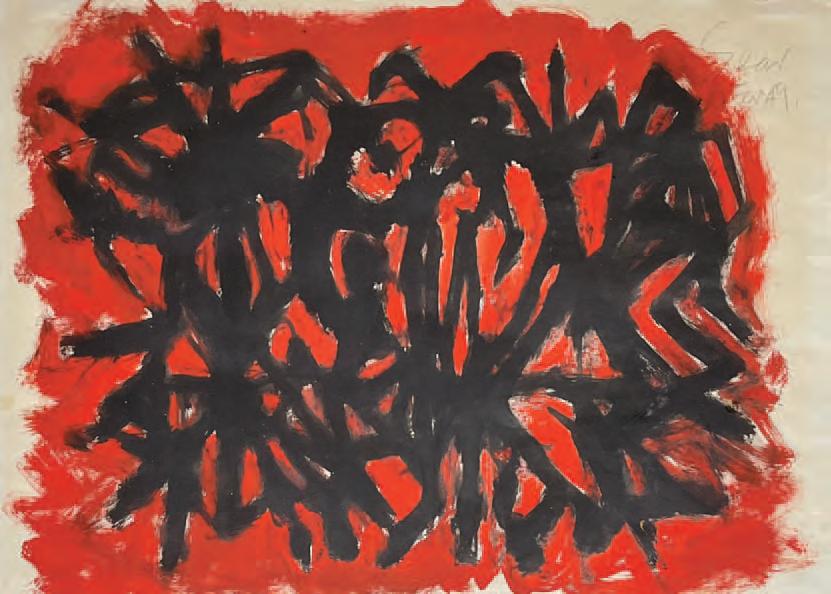
[cat.69]
William Gear, RA (1915-1997)
Black Composition on Red
Signed and dated 49 Gouache and oil on paper 32 by 43 cm, 11 ½ by 17 in Provenance: The Redfern Gallery, London
William Gear, Painter and administrator, born in Methil, Fife. He studied painting at Edinburgh College of Art, 1932-7, and the Edinburgh University Fine Art Class, 1936-7, his teachers including William Gillies and John Maxwell. After study in Paris with Fernand Léger in 1937 he travelled in Italy and the Balkans area on the strength of a scholarship. After World War II service in the Army and a period in the Control Commission in Germany, Gear lived in France until 1950, when he returned to Britain and in 1951 won a Festival of Britain Purchase Prize. In 1958 was made curator of Towner Art Gallery in Eastbourne. He was appointed head of the faculty of fine art in Birmingham College of Art in 1964; guest lecturer at National Gallery of Victoria, Melbourne, and University of Western Australia, Perth, in 1966; and in 1975 won the Lorne Fellowship and retired as head of the department of fine art at Birmingham Polytechnic. By then Gear had built up an impressive international exhibiting record, a painter of abstract compositions, often dancingly powerful in colour, who made a significant contribution to European painting through his association with the COBRA group in the immediate post-war years. Fifty-year retrospective at Redfern Gallery, 1997, with another there in 2003. William Gear and COBRA toured from Aberdeen Art Gallery, 1997-8. Tate Gallery and many provincial and foreign collections hold Gear's work. Elected Senior RA, 1995. Lived in Birmingham.

Rest in the Fields
Pen, ink and wash 17 by 22.5 cm, 6 ¾ by 8 in.
Provenance: Roland, Browse and Delbanco, London
Josef Herman (3 January 1911 – 19 February 2000), was a highly regarded Polish-British painter who influenced contemporary art, particularly in the United Kingdom. He was part of a generation of central and eastern European Jewish refugee artists who emigrated to escape Nazi persecution. He saw himself as part of a tradition of European figurative artists who painted working people, a tradition that included Courbet, Millet and Van Gogh, Kathe Kollwitz and the Flemish Expressionist Constant Permeke. For eleven years he lived in Ystradgynlais, a mining community in South Wales.

[cat.71]
John Piper, CH (1903-1992)
St. Kew, Cornwall
Signed, titled and dated Oct ‘62 Pen, ink, watercolour and gouache
35.5 by 53.5 cm, 14 by 21 in.
Exhibited: London, Marlborough Fine Art, ‘John Piper Retrospective’, March 1964, no.129
John Piper, painter, notably of architecture and landscape, designer of stained glass and for the theatre, and writer, born in Epsom, Surrey. His first wife was the artist Fileen Holding, his second the writer Myanwy Evans, and his son the artist Edward Piper. From 1921-6 studied law and worked in his father’s solicitor’s office before studying at Richmond and Kingston Schools of Art and Royal College of Art, 1926-9, In mid-1930s after a visit to Paris concentrated on abstract painting, but then reverted to representational work. First solo show, of collages and drawings, at London Gallery, 1938. Member of LG in 1933 and 7 & 5 Society, 1934-5. Piper was a prolific writer, working for The Athenaeum, New Statesman, Nation and Architectural Review, publishing his first guide book in 1938. With his wife he produced the influential Axis - a Quarterly Review of Contemporary “Abstract” Painting and Sculpture, 1935-7. From 1940 for about 20 years had one-man shows with Leicester Galleries. His ballet designs included The Quest, 1943 and Job, 1948, as well as operas for Benjamin Britten. Piper was an Official War Artist in World War II. In 1942 he published his best-selling monograph English Romantic Artists. Was on several occasions a trustee of Tate Gallery, member of the Arts Council panel and a member of Royal Fine Art Commission. Stained glass window designs included Coventry Cathedral and Christchurch College Chapel, Oxford. Made Companion of Honour, 1972. Retrospectives were held at Museum of Modern Art, Oxford, 1979, and Tate Gallery, 1983. Goldmark Gallery, Uppingham, gave Piper centenary shows in 2002 and 2003 and Pallant House Gallery, Chichester, one in 2003, the year that Dulwich Picture Gallery staged John Piper in the 1930s and Sherborne House, Dorset, its exhibition John Piper: A Versatile Artist. The Tate, Arts Council and many provincial galleries hold his work. Died at Fawley Bottom, Oxfordshire.

[cat.72]
Signed, titled and dated Oct ‘64 Ink, watercolour and gouache 56 by 76 cm, 22 by 30 in
Alan Davie, painter, born in Grangemouth, Stirlingshire, whose father was a painter and printmaker. Studied at Edinburgh College of Art, 1937-40, where he was influenced by John Maxwell. Won several scholarships. After serving in Army in World War II Davie worked for a time as a professional jazz musician. He was also interested in writing poetry, designed textiles and pottery and worked as a jeweller. By the time of his first solo show, at Grant’s Bookshop, Edinburgh, in 1946, Davie’s interest in the work of Paul Klee and primitive artists was evident. Over the years there were a number of such influences on his work: the American Abstract Expressionists such as Pollock and Gorky, Oriental mysticism including Zen Buddhism, gliding and swimming and Indian mythology. Davie viewed art as a way of gaining spiritual enlightenment. His later work was less expressionistic, more full of symbolism. In 1947 Davie married the artist and potter Janet Gaul, travelled in Europe and met Peggy Guggenheim, the collector, which expanded his horizons. From 1950 he was having solo shows with Gimpel Fils and had his first New York exhibition at the Catherine Viviano Gallery in New York in 1956. Was Gregory Fellow at Leeds University, 1957-9. In 1962 Davie had retrospective at Stedelijk Museum, Amsterdam, which toured, and from then he consolidated his international reputation with a number of overseas retrospectives. Fifty-year retrospective at McLellan Galleries, Glasgow, 1992, also at Barbican Art Gallery, 1993. Later shows included Scottish National Gallery of Modern Art, Edinburgh, 2000-1; Adam Gallery, Bath, 2001, an eightieth-birthday show toured by the University of Brighton; Gimpel Fils, 2001-2, small paintings from 1949-2001; and paintings and screenprints at Mercer Art Gallery and Godfrey & Watt, both in Harrogate, 2002. Jingling Space, at Tate St Ives in 2003-4, highlighted the evolution of Davie’s work from the 1930s, particularly relating to his interest in Surrealism. Open Eye Gallery, Edinburgh, held an exhibition in 2004 in which recent paintings by Davie revealed that his capacity to create rich imagery was not diminished by age. Tate Gallery holds his work, Lived in Hertfordshire, St Lucia and Cornwall.
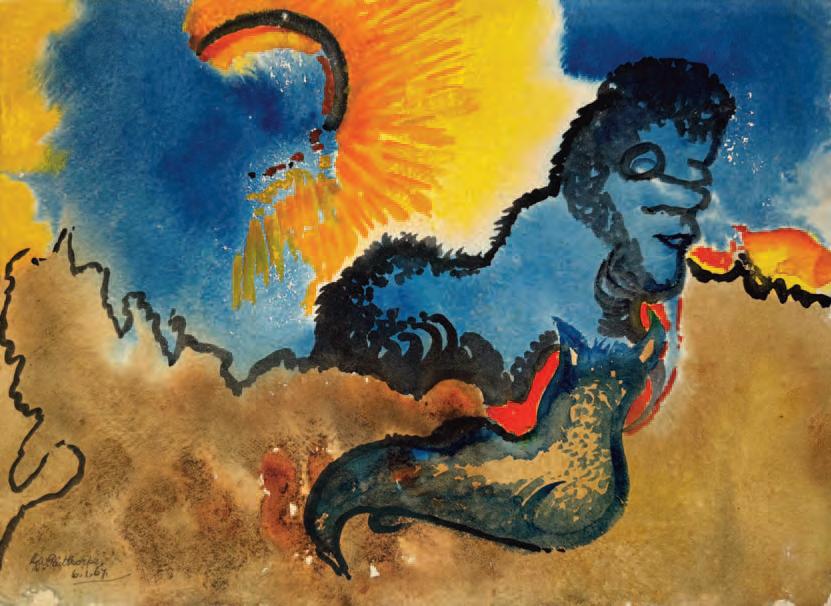
[cat.73]
Sun and Slug
Signed and dated 6.1.67
Ink, watercolour and gouache
28 by 39 cm, 11 by 15 ¼ in.
Grace Pailthorpe, Surrealist artist and writer, born Sussex, married to the painter Reuben Mednikoff, also known as Ricky Pailthorpe. She served as a surgeon in World War I, worked as a district medical officer in Western Australia, 1918-22, returned to England to study psychological medicine, published books on delinquency and set up what eventually became the Portman Clinic, for its treatment. Met Mednikoff in 1935, and they embarked on a life study of psychological art research. Automatism was the key to their art theory and practice. In the 1930s Pailthorpe contributed to main Surrealist shows, but she fell out with the British Surrealist group in late 1930s, having published The Scientific Aspect of Surrealism in 1938, being expelled two years later. Continued to paint and research until her death. Was included in Women Artists of The British Surrealist Movement, 1930-1990, at John Bonham, Murray Feely Fine Art, 1992. Leeds City Art Gallery held a a retrospective of Dr Pailthorpe’s and Mednikoffs work, Sluice Gates of the Mind, 1998, the exhibition being opened by veteran Surrealist Conroy Maddox. See also exhibitions at Mayor Gallery, 1998, and Steven Joseph Pollock Fine Art, 2001.

[cat.74a]
Signed with monogram; annotated beneath the mount Pencil and pastel
16.5 by 16 cm, 6 ½ by 6 ¼ in.
Provenance: The Estate of the artist
Maxwell Armfield, painter and decorative artist, especially in tempera, and writer. Born in Ringwood, Hampshire, Armfield was educated at Birmingham School of Art - there is a Birmingham Arts and Crafts flavour in his pictures - then in Paris and Italy. Exhibited extensively, including RA, Fine Art Society, for long a noted dealer in his work, NEAC, Leicester Galleries and abroad. His work is held by the British Museum, provincial and overseas galleries. He illustrated about 20 books and wrote A Manual of Tempera Painting, Tempera Painting Today, An Artist in America and An Artist in Italy. During World War I, with his writer wife Constance Smedley, Armfield attempted to set up a high-flown peoples’ Greenleaf Theatre in his studio, an abortive venture amusingly recalled by Margaret Gardiner in her book A Scatter of Memories. Armfield was a painter of landscape and still life well crafted and full of detail. Lived in Bath, Somerset.

Two Studies of a White
Framed as one Pencil and pastel
Total: 18 by 10.5 cm, 7 by 4 in.
Provenance: The Estate of the artist
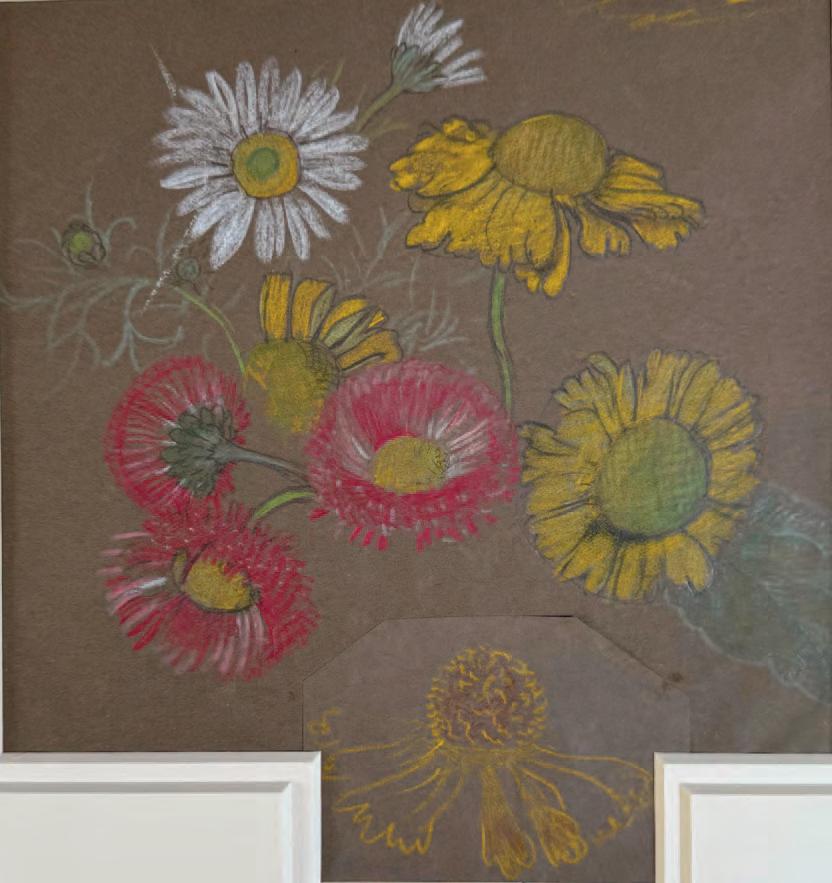
Maxwell Ashby Armfield (1881-1972)
16 by 15 cm, 6 ¼ by 6 in
Provenance: The Estate of the artist

Pencil and pastel
14 by 14 cm, 5 ½ by 5 ½ in.
Provenance: The Estate of the artist
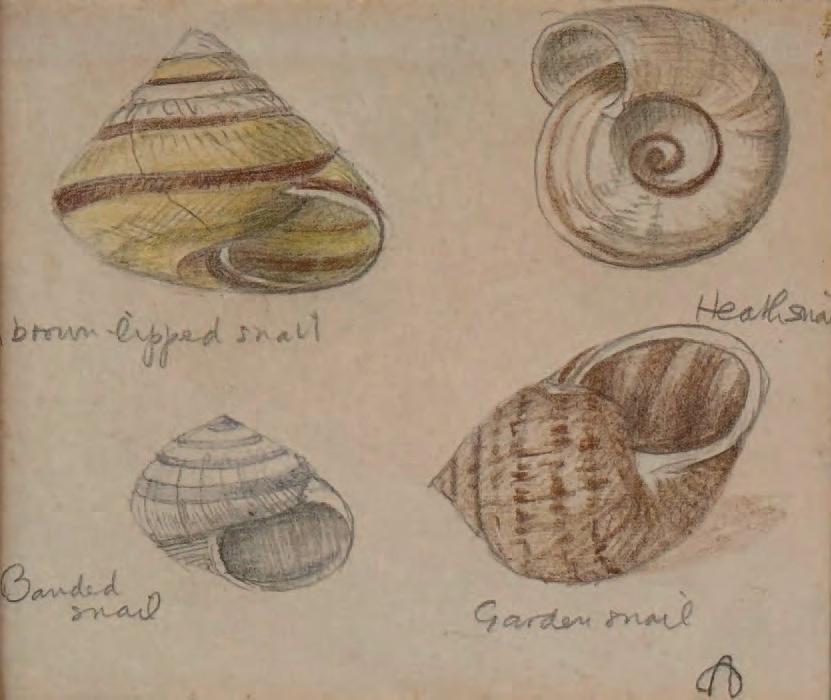
[cat.74e]
Maxwell Ashby Armfield (1881-1972)
Snail Studies
Signed with monogram and inscribed
Pencil and pastel
9 by 10.5 cm, 3 ½ by 4 in.
Provenance: The Estate of the artist

[cat.74f]
Pencil and pastel
17.5 by 23 cm, 7 by 9 in.
Provenance: The Estate of the artist
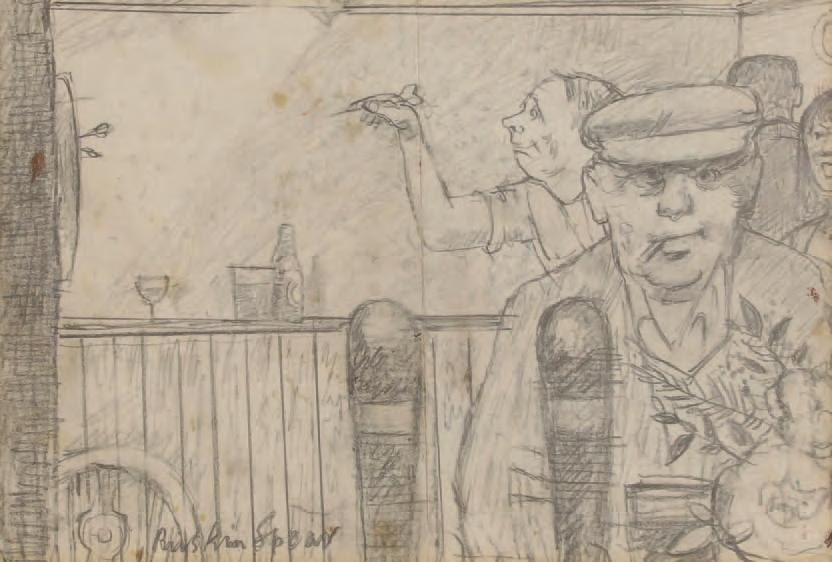
Signed Pencil
19.5 by 28.5 cm, 7 ¾ by 11 ¼ in.
Provenance: Jonleigh Gallery, Surrey
Ruskin Spear, painter and teacher, full name Augustus John Ruskin Spear, born in Hammersmith, London, where he spent most of his life and which he frequently painted. An attack of polio as a child badly affected one leg, so he attended Brook Green School for crippled children. Aged 15 won scholarship to Hammersmith School of Art, another scholarship in 1930 taking him to the Royal College of Art for four years under William Rothenstein. In 1934 became part-time tutor at Croydon School of Art; he was eventually to teach at St Martin’s School of Art, Central School of Arts and Crafts and Hammersmith School of Art, in 1948 becoming tutor at the Royal College of Art, where he remained until 1975. These were years which brought in such movements as Kitchen Sink and Pop Art. Spear was to retain his individuality as an essentially English painter in the Sickert tradition, a reflection of his working-class Cockney background being his pictures of seedy street and barroom life. He exhibited at the RA from 1932 and for the Summer Exhibition provided talking-point portraits of Winston Churchill, Princess Anne and Margaret Thatcher. His outstanding portraits included fellow-painter Carel Weight, Lord Hailsham and Lord Olivier, the actor. Elected RA in 1954. Painted an altarpiece for the Royal Air Force church St Clement Danes and designed murals for the liner Canberra. Retrospective at RA in 1980 was a popular and critical success. Work in many public collections.

[cat.76]
John Bratby, RA (1928-1992)
Lillies
Signed and dated 6.71
Watercolour and gouache
40 by 50 cm, 15 ¾ by 19 ¾ in.
John Bratby, painter, novelist and teacher, born in London. He studied at Kingston School of Art, 1948-9, then Royal College of Art, 1951-4. Married the painter Jean Cooke, 1953, marriage dissolved in 1977. Through the 1950s Bratby regularly showed at Beaux Arts Gallery in solo exhibitions, the first being in 1954. He won Abbey Minor, Italian Government and Royal College of Art Minor Travelling Scholarships in 1954, the year following receiving a prize in the Daily Express Young Artists Competition. Bratby taught at Carlisle College of Art, 1956, then at Royal College of Art, 1957-8. He represented Britain at Venice Biennale in 1956 and gained the Guggenheim Award, and in 1958. In that year he was commissioned to paint the pictures for the film of Joyce Cary’s novel The Horse’s Mouth. He wrote his own first novel, Breakdown, 1960. Bratby was a prolific exhibitor, having painted over 1,500 portraits alone by 1991, when a retrospective was held by National Portrait Gallery, which holds his work. In the same year there was a solo show at Albemarle Gallery and the Mayor Gallery included him in The Kitchen Sink Artists Revived, which drew attention to his 1950s pictures. After a retrospective at Catto Gallery, 1997, there were shows at The Millinery Works, 1999 and 2002. Bold images, thick paint and primary colours were Bratby’s trademarks. He was elected RA in 1971. Lived in Hastings, Sussex.
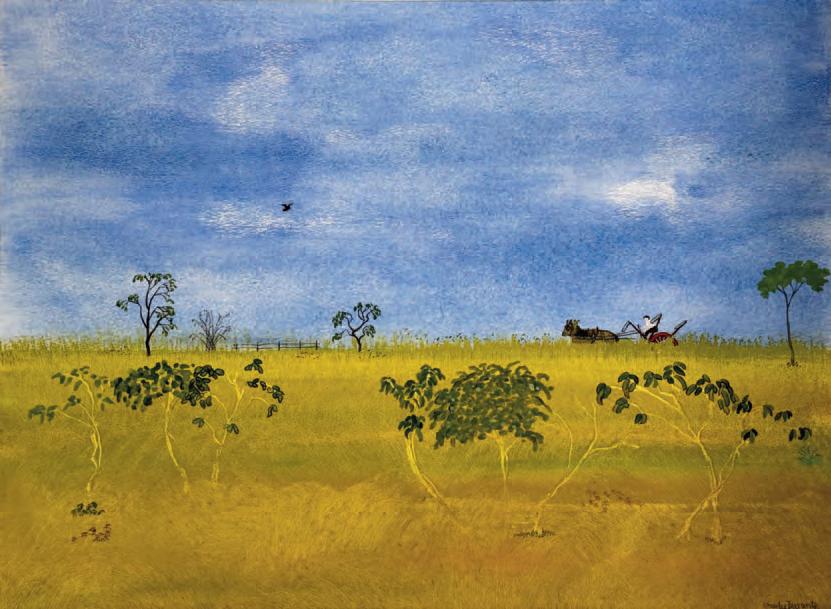
Signed; also signed and titled on a label attached to the backboard
Watercolour and gouache
35.5 by 28.5 cm, 14 by 19 in.
Provenance:Thackeray Gallery, London
Charles Duranty, watercolourist, born in Romford, Essex, who was selftaught. He worked in journalism, agriculture and for most of his life in book publishing, finally with Gerald Duckworth & Company. He published a small collection of his verse, Audition. Duranty said that his pictures were “a personal interpretation of rural life in Essex and Suffolk in the past half century”. He took part in many group shows, including Thackeray, New Grafton and Leicester Galleries; Roland, Browse & Delbanco; Mercury and Zwemmer Galleries and abroad. Solo exhibitions included Thackeray and New Grafton Galleries. Paintings in Hospitals, the Wentworth Hotel in Aldeburgh and private collections hold Duranty’s works. Lived in Merrow, Guildford, Surrey.

Signed
Watercolour and gouache
25.5 by 51 cm, 10 by 20 in.
Provenance: Thackeray Gallery, London

Signed; also signed and titled on a label attached to the backboard
Watercolour and gouache
14.5 by 21.5 cm, 5 ¾ by 8 ½ in.

Devon Scene
Inscribed with colour annotations
Pencil and watercolour
20.5 by 27.5 cm, 8 by 10 ¾ in.
Provenance: Collection of Sven Berlin
Adrian Ryan, painter and teacher, born in London, son of the landscape and portrait artist Vivian D Ryan. Adrian Ryan studied at Architectural Association,1938-9, and Slade School of Fine Art, 1939-40. He taught at Goldsmiths’ College School of Art, 1948-83. Over the years he painted in a variety of places, including Cornwall, France and Suffolk, being latterly based in London and Suffolk. As well as appearing in various mixed shows, including LG and RA, he had a number of one-man shows, starting with the first of a series at Redfern Gallery in 1943. Later solo exhibitions included University of West Virginia in 1978, Gallery 10 in 1980, a retrospective at The Minories, Colchester, 1985, another with the National Trust, 1994, and in 1996 a solo show at Eton College, which he had attended. There was a memorial show at Redfern Gallery, 2000, another at Penlee House Gallery & Museum, Penzance, 2002. An exhibition at Charleston Gallery, Firle, in 2003, organised by Julian Machin, concentrated on Ryan’s paintings of France. Machin also arranged a show of Ryan’s Still Life Paintings at Sutton House, 2 & 4 Homerton High Street, in 2005. Tate Gallery holds his Flowers on a Chair.

[cat.79]
John Piper CH (1903-1992)
Obelisks
Watercolour, collage, wax
41.5 by 73 cm, 16 ¼ by 28 ¾ in.
Exhibited: London, Chris Beetles Ltd., Summer Show, 1 May 2003, cat.no.92

[cat.80]
John Copnall (British, 1928-2007)
Star (purple and orange)
Signed and dated ‘89
Watercolour and acrylic
32 by 34 cm, 12 ½ by 13 ½ in.
John Copnall, painter and teacher, born in Slinfold, Sussex, son of the sculptor Bainbridge Copnall. He studied at the Architectural Association, 1945-6; did his National Service in the Army; from 1949-50 studied with his father at Sir John Cass College; then under Henry Rushbury at the Royal Academy Schools until 1954, the year he won the Turner Gold Medal for landscape painting. Went to Spain to live until 1958, initially being a figurative painter, but by the time he returned he was committed to abstraction. Gesture and colour are distinguishing features of Copnall’s work, themes derived from sources such as jazz, windowbars in a studio or landscape. Copnall taught for many years from 1973 at Central School and was a visiting teacher at Canterbury College of Art for a time. He won an E A Abbey Scholarship in 1970; Arts Council Awards, 1972-3; a British Council Award, 1979; and in 1989 was elected a LG member. Group shows included Wildenstein, 1958; Annely Juda Fine Art, from 1969; John Moores Liverpool Exhibition, from 1972; RA Summer Exhibition, from 1980; British and Irish Modernist Art, Christie’s, 1986-9; and Cross Currents, Reed’s Whart Gallery at Barbican Centre, 1996. Had a solo exhibition at Piccadilly Gallery, 1955, later ones including Reed’s Wharf and De La Warr Pavilion, Bexhill-on-Sea, both 1996. In 2005, Modern British Artists showed Landscape Forms, Copnall’s early works. Arts Council, Aberdeen and Bristol public galleries and other notable collections hold examples. Lived in London.
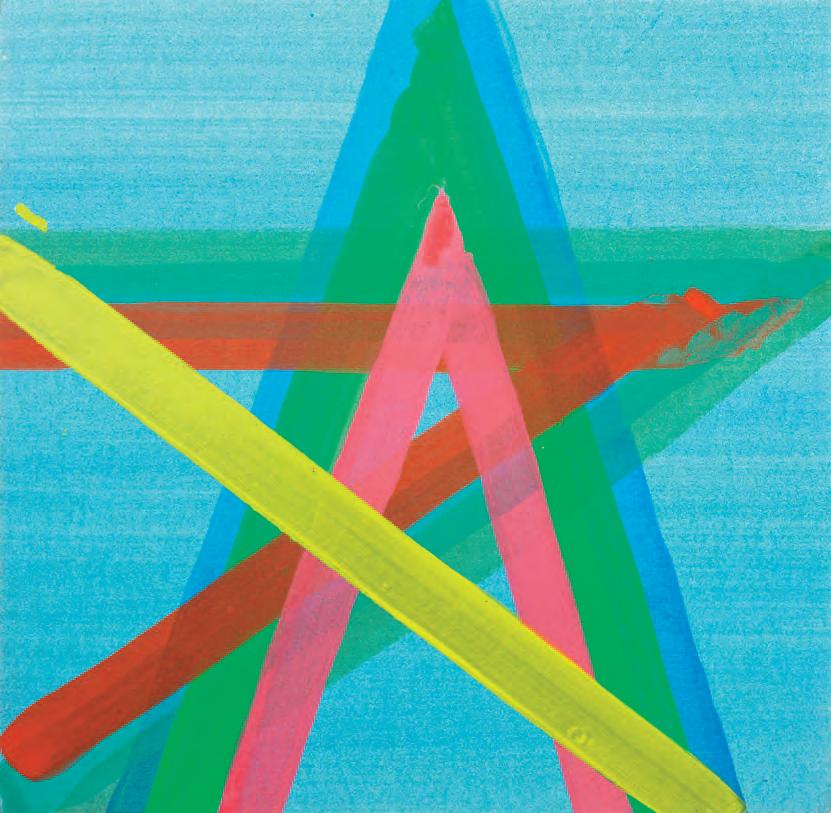
[cat.81]
John Copnall (British, 1928-2007)
Star (blue and green)
Watercolour and acrylic
34.5 by 35 cm, 13 ½ by 13 ¾ in.

[cat.82]
John Copnall (British, 1928-2007)
Star (purple and green)
Watercolour and acrylic
33.5 by 33 cm, 13 ¼ by 13 in.

[cat.83]
Sir Eduardo Paolozzi, RA (1924-2005)
Spaceship and Parrot
Gouache over a printed base 27 by 18 cm, 10 ¾ by 7 in.
Eduardo Paolozzi, sculptor, draughtsman, designer, printmaker and teacher, born in Leith, Mid-lothian, of Italian parents. Studied at Edinburgh College of Art, 1943, and Slade School of Fine Art, 1944-7. After Army service he worked in Paris, 1947-50, his work being shown at Galerie Maeght in 1948. His first one-man show was at Mayor Gallery, 1947 and in New York at Betty Parsons Gallery, 1960. By then Paolozzi had been represented at Venice Biennale in 1952, São Paulo Bienal in 1957, Documenta II, Kassel, 1959, and in various touring shows. After then Paolozzi’s work was shown internationally, including Tate Gallery retrospective, 1971, and seventieth birthday show, Yorkshire Sculpture Park, Wakefield, 1994. The Scottish National Gallery of Modern Art, Edinburgh, holding the most extensive collection of his work, put on Paolozzi at 80 in 2004. Three years before, Paolozzi had suffered a near-fatal stroke that from then on largely confined him to bed. Flowers East put on a key show in 2005 covering his public commissions, including the Tottenham Court Road Underground designs. Was an influential teacher, including St Martin’s School, 1955-8, where he taught sculpture; Royal College of Art, where he lectured in ceramics, 1968-89, from which time he was visiting professor; and at schools in Hamburg, Cologne and Munich, Germany, starting in 1960, teaching ceramics and sculpture. From 1996 he was visiting professor at Edinburgh College of Art. Winner of many awards. Produced several films and books. Among his commissions was a cast iron sculpture to Bruckner the Austrian composer, in Linz, 1977; four cast-aluminum doors for Hunterian Gallery, Glasgow, 1976-80; Master of the Universe, a bronze for Kowloon Park, Hong Kong, 1987-88; Newton after James Watt, bronze for Design Museum, London, 1989-90; and Newton, British Library, 1995. Elected RA, 1979; knighted in 1988. In 1999 the new Dean Gallery, Edinburgh, was opened to house the 1994 Paolozzi Gift and a recreation of his studio. The gift comprised about 5,000 works and found objects collected by him. From early in his career Paolozzi amassed a huge collection of toys and gifts, the Krazy Kat Archive, a selection of which is held by the Victoria & Albert Museum. All this contributed to the prolific output of this most energetic artist, the solemnity of whose work was tempered by humour, one of the fathers of British Pop Art. Lived in London.

[cat.84]
John Bratby, RA (1928-1992)
Goat and Saucepan
Signed Charcoal and pastel 39 by 56cm, 15 ½ by 22 in.

[cat.85a]
Sir Terry Frost, RA (1915-2003)
Black and Red Decoration
Signed, inscribed and dated 87 on the reverse Gouache and collage
10 by 7.5 cm, 4 by 3 in.
Terry Frost, painter, printmaker and teacher, born in Leamington Spa, Warwickshire. Did a variety of jobs after leaving school, then served in the Army and was held as a prisoner of war. Imprisoned in Bavaria he met the painter Adrian Heath who encouraged Frost to paint in oil. After the war Frost studied in the evenings at Birmingham College of Art, then at St Ives School of Painting and at Camberwell School of Art in the late 1940s. Frost later went on to teach at a number of art schools, including periods at Reading and Newcastle Universities and at Banff Summer School, Canada. Frost began abstract painting in 1949, shortly before returning to St Ives where he worked, 1950-2, as assistant to the sculptor Barbara Hepworth. Frost is notable for his use of primary colours and of shapes reflecting Cornish marine life, its bobbing boats and heaving water. Completed much work in paint and collage, which has a spare, taut quality. He exhibited widely internationally and in England, notably at Redfern Gallery, New Art Centre, Austin/Desmond Fine Art, and Belgrave Gallery, with a retrospective at RA, 2000. Tate St Ives and Belgrave Gallery both gave Frost shows in 2003, Belgrave Gallery St Ives showing works on paper from the artist’s studio in 2004 and 50 Years of Prints in 2006.
Frost, whose son was the artist Anthony Frost, was elected RA in 1992 and was knighted in 1998. Tate Gallery holds his work. Had a studio at Newlyn, Cornwall.

[cat.85b] Sir Terry Frost, RA (1915-2003) Red to Black Squeeze
Signed, inscribed and dated 93 on the reverse Gouache and collage 9 by 20.5 cm, 3 ½ by 8 in.

[cat.85c]
Sir Terry Frost, RA (1915-2003)
Green, Orange and Blue, a Christmas Card
Signed; inscribed All the best for Xmas & New Year To Adrian, Alyson & Amy, Lots of love from from Kath & Terry Gouache and collage 10 by 12 cm, 4 by 4 ¾ in.

[cat.85d]
Sir Terry Frost, RA (1915-2003)
Hearts, a Christmas Card
Signed; inscribed To Amy and Alyson, All the very best, hope we see you soon.
A very Happy Xmas and great 94 from Kath & Terry
Gouache and collage
13.5 by 6 cm, 5 ½ by 2 ½ in.

Signed and inscribed Lots of good wishes to Adrian, Alyson & Amy for Xmas 1987 from Kath & Terry
Gouache and collage
15 by 4.5 cm, 6 by 1 ¾ in.

[cat.86]
Signed and dated 1990
Pen, ink, watercolour and gouache 11 by 11 cm, 4 ½ by 4 ½ in.
Dora Holzhandler, painter in the naïve style, born in France. She became a student at Anglo-French Art Centre in London in 1946 where she met her future husband, George Swinford, and settled in Hampstead. She exhibited at Young Contemporaries in 1949 and at Beaux Arts Gallery in 1954 in mixed exhibitions, and many such appearances followed in Britain and abroad. Had a solo exhibition at Chenil Gallery in 1960, others including a series at Langton Gallery in the 1970s, Concourse Gallery, 1984-5, Crane Kalman, 1985, Graham Modern Gallery in New York in 1986, Bowmoore Gallery, 1989-91, Beaux Arts, Bath, 1996, Judy Saslow Gallery, Chicago, America, 1998, and Piano Nobile Fine Paintings, 2001 and 2004. Among Holzhandler’s later travels was a trip to Dharamsala, India, in 2002, for an audience with His Holiness The Dalai Lama of Tibet with her husband George and granddaughters Tara and Eve. Eric Newton, the Manchester Guardian critic, called Holzhandler’s work that of “a temperamental primitive ... colourful as a Persian illumination, always brilliant, but never harsh.” Nuffield Foundation, Museum of London, the Gallery of Modern Art in Glasgow, Brighton Art Gallery and Museum and a number of notable private collectors hold examples. Retrospective at the Ben Uri Gallery, 2006.

Dora Holzhandler (1928-2015)
The Bather
Signed and dated 2000
Pen, ink and watercolour
14 by 12 cm, 5 ½ by 4 ¾ in.
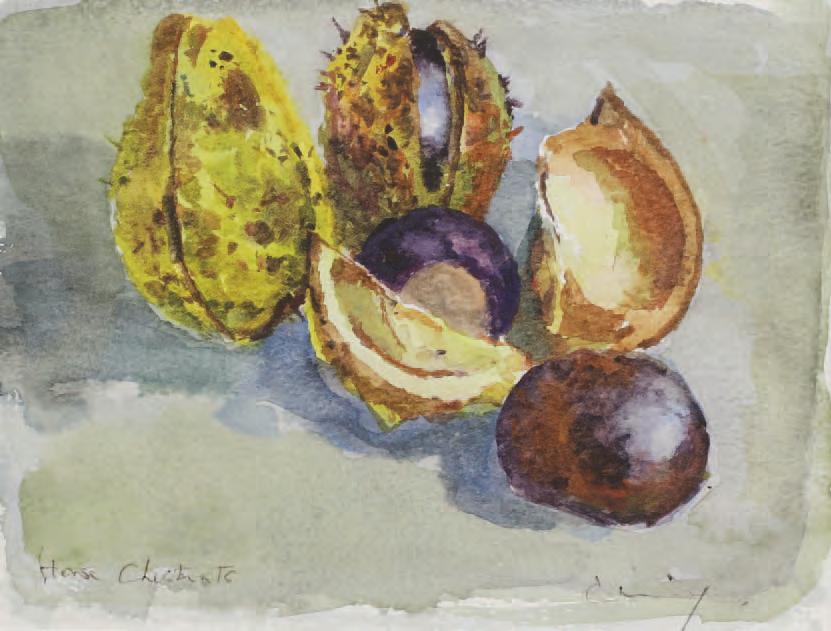
[cat.88]
Fred Cuming, RA (1930-2022)
Signed and titled; inscribed To Freda, Happy 90th Birthday, Lots of Love, Fred and Audrey xxxx on the reverse Watercolour 16 by 20.5 cm, 6 ¼ by 8 in.
Frederick Cuming, painter, born in London, of English, Scottish and Irish descent. A subtle Colourist who specialised in landscapes in Britain and on the continent. He trained at Sidcup School of Art, 1945-9, and after National Service attended Royal College of Art, 1951-5, winning an Abbey Minor Travelling Scholarship which took him to Italy. Was elected RA in 1974. He took part in many mixed shows and had a string of one-man exhibitions, including New Metropole Gallery, Folkestone; Leonie Jonleigh, Guildford; Little Studio, New York; and from the early 1980s a number at New Grafton Gallery.

[cat.89]
Signed with initials and dated ’95; also titled and dated ’95 on the reverse Pen, ink and watercolour 38 by 56 cm, 15 by 22 in.
Artist, writer and teacher obsessed by mystical intimations which he found in everyday things and landscape. He was born, with his elder twin Geoffrey, in London into comfortable circumstances. At Eton College he developed as an artist and was an outstanding field and track sportsman. Rossiter was commissioned in the Welsh Guards and while inspecting a cookhouse in Greece “sensed a transcendental state of glory”. He felt “as if the secrets of the world had been unfolded before me, and I was walking with God in the Garden of Eden.” Rossiter was put in a straitjacket, suffered a nervous breakdown and a femoral thrombosis which temporarily deprived him the use of his legs and was invalided out of the Army in 1947. He studied at Chelsea Polytechnic under Henry Moore and Robert Medley, 1947-51; taught at St Andrew’s School, Pangbourne, and became absorbed by landscape painting; in 1955 joined the staff of Millfield School, but was still in and out of hospital; then in 1957 married Anneka Oving, a Dutch nurse, who provided stability for Rossiter to flourish as a painter in the Mendip Hills and to teach at the Royal West of England Academy (later the Bristol Polytechnic), 1960-83. In the latter year he formed Dalesford Studio for personal tuition in art, an extension of his own studio.
Signed with initials and dated ’93; also signed, titled and dated ’93 on the reverse
Watercolour and gouache
38 by 26.5 cm, 15 by 10 ½ in

From the mid-1950s he showed in London and the provinces. His autobiography The Pendulum was published in 1966, linked to a retrospective at Reading Museum and Art Gallery. A show of his work organised by The Lincolnshire Association in 1969 toured the county. Influenced by Dom Aelred Watkin, headmaster of Downside School, he was received into the Roman Catholic church. In 1984, he was elected RWA. Rossiter explained the sources of his art in The Golden Chain, 1970, reviewed appreciatively by the poet W H Auden, who became his friend and the subject of several portraits. In 1980, he illustrated Elizabeth Jennings’ poems A Dream of Spring. The Victoria & Albert Museum, Ashmolean Museum in Oxford and Smithsonian Institution, Washington, America, hold examples. Lived at Litton, Somerset.

[cat.91]
Rose Hilton (1931-2019)
Nude on the Sofa
Oil, ink and wash
24 by 31.5 cm, 9 ½ by 12 ½ in.
Painter, born in Kent. After initial training at Beckenham School of Art she went on to study at Royal College of Art, 1954-7. From there travelled to Rome for a year on an Abbey Minor Scholarship. Back in England she met and married the painter Roger Hilton and they moved to Botallack, Cornwall. She then brought up her children and looked after her husband during his long illness, but painted little herself. After Roger’s death she resumed painting and took drawing lessons in the mid-1980s from Cecil Collins. Her exhibitions included Newlyn Orion Gallery, 1977 and 1987; Michael Parkin Gallery, 1988; Oxford Gallery, 1989; David Messum, 1991; and North Light Gallery, Huddersfield, 2002. In that year she showed at Badcocks Gallery, Newlyn, with one of her sons, Fergus. She was a richly colourful painter of people and interiors.

Pastel
29 by 42 cm, 11 ½ by 16 ½ in.

Pen, ink and wash
37 by 28 cm, 14 ½ by 11 in.
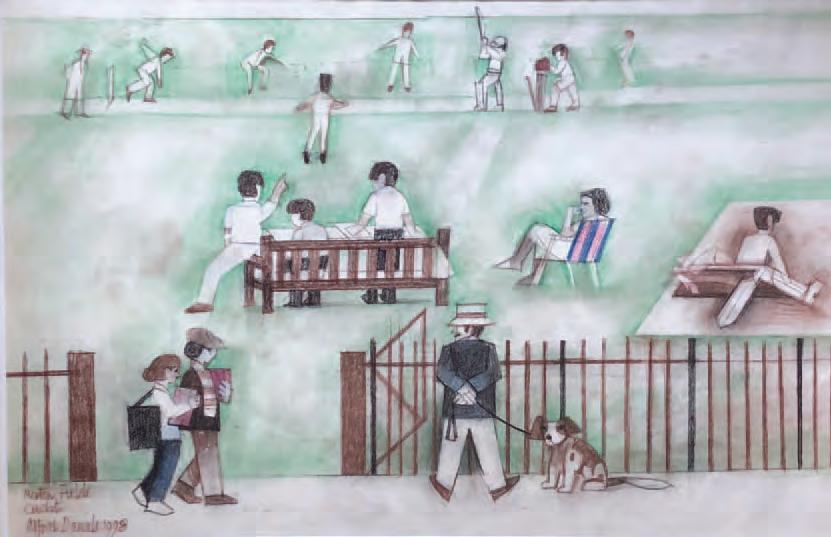
Merton Fields, Cricket
Signed, titled and dated 1998
Coloured pencils
31 by 49 cm, 12 by 19 ¼ in.
Painter, teacher and writer of books on art, born in London, where he continued to live. Daniels studied at Woolwich Polytechnic, 1943-4, then service in the Royal Air Force, resuming his studies at Royal College of Art, 1947-50, undertaking postgraduate studies in mural design, 1950-2. Daniels was to hold a number of teaching posts: from 1951-76 at Hornsey College of Art; from 1964-9 part-time at Royal College of Art; from 1973-88 parttime at Sir John Cass, City of London Polytechnic; 1976-80 part-time at Middlesex Polytechnic; then again at the Royal College, 1984-7. Daniels showed widely in mixed shows from the early 195Os. He was one of Jack Beddington's Young Artists of Promise, in the 1957 book of that title, and his stylised depiction of people and places remained remarkably consistent. He handled a number of commissions, including murals for Hammersmith Town Hall. His books included Painting and Drawing, 1961; Drawing Made Simple, 1962; and Landscape Painting in Watercolour and Oil, 1980. His many solo shows included Zwemmer Gallery from mid-1950s, later ones including Belgrave Gallery, 1989: Alfred Daniels in Israel. Daniels was a member of RWS and RBA. Leeds University and Greater London Council held his work.

Signed and titled Watercolour 76 by 56 cm, 30 by 22 in.
Painter, born into a fishing family at Port Seton, East Lothian. He attended Edinburgh College of Art, 19605. During his time there, in 1962, he won an Andrew Grant Scholarship, permitting travel to Paris; and for several years with Alexander Moffat he showed his pictures outside RSA, in opposition to the Establishment, work in the Northern European Expressionist-Realist tradition. Studied at Royal College of Art, 1965-8, where he continued to develop his personal symbolism, fed by travels to the Low Countries and Germany and the works and sights he saw there. A large number of watercolour portraits was completed in the 1980s, following a series of serious illnesses. By then Bellany was recognised as an artist of international stature. Had many solo shows, including The Dromidaris Gallery, Netherlands, 1965; a series at Drian Gallery in 1970s; Compass Gallery, Glasgow, 1987 and 1990 Beaux Arts, from 2000; University of Northumbria, Newcastle upon Tyne, 2001; and John Bellany at Sixty, Scottish National Gallery of Modern Art, Edinburgh, 2002; and abroad. His works are in principal public galleries in Britain, including Tate Gallery and Scottish National Gallery of Modern Art. Lived in London and was made RA in 1991.

[cat.96a]
Breon O’Casey (1928-2011)
Triangles (Blue dots), a Christmas Card
Inscribed inside To Shivaun & Co, Happy Christmas, love from, Breon Doreen et al Gouache, pastel and collage 11 by 17.5 cm, 4 ¼ by 7 in.
Painter, jeweller and relief construction maker, born in London, son of the Irish dramatist Sean O'Casey. In 1939 the family moved to Devon, where Breon attended Dartington Hall School and was taught metalwork by the ex-Bauhaus teacher Naum Slutski. After studying three years at the Anglo-French Art Centre, O'Casey moved to St Ives, becoming assistant to the sculptor Denis Mitchell, then Barbara Hepworth. Mixed shows included the RWA's Artists from Cornwall, 1992; Shining Through, Crafts Council, 1995; and Gordon Hepworth Fine Art, Newton St Cyres, 1997. Had many solo exhibitions, including Victoria & Albert Museum Craft Shop, 1985; The Oxford Gallery, Oxford, from 1985; Taylor Galleries, Dublin, 1988; Collier/Campbell, 1990; Berkeley Square Gallery, 1999 and 2003; Scolar Fine Art, 2001; and Six Chapel Row, Bath, 2005. Arts Council; Kettle's Yard, Cambridge; Plymouth Museum and Art Gallery; Trinity College, Dublin; and Victoria & Albert Museum hold examples.

Breon O’Casey (1928-2011)
Blue and Red with gold stars, a Christmas Card
Inscribed inside Merry Christmas and a Happy New Year
Gouache, collage and gold paint
12.5 by 10 cm, 5 by 4 in.

[cat.96c]
Breon O’Casey (1928-2011)
Crescents, a Christmas Card
Inscribed inside To Eileen, Merry Christmas, A Happy New Year, & Happy Birthday, with love from Breon Gouache and gold paint 11.5 by 18 cm, 4 ½ by 7 in.

[cat.96d]
Breon O’Casey (1928-2011)
Three Forms, a Birthday Card
Inscribed inside Happy Birthday, Love from Breon & Doreen
Gouache and collage
10.5 by 16 cm, 4 ¼ by 6 ¼ in.
[cat.97]
Maurice Cockrill, RA (1936-2013)
Black and Ochre Abstract
Signed twice and dated 2000 Ink and acrylic on paper 114 by 42 cm, 45 by 16 ½ in.
Painter and teacher, born inHartlepool, County Durham. He had a peripatetic childhood and after leaving school did a variety of jobs. In the late 1950s he studied painting at evening classes, then in 1960 was accepted by Denbigh Technical College to study painting full-time, attending University of Reading, 1963-4. Taught, including Liverpool College of Art and Liverpool Polytechnic. Took part in group shows including Neptune and Everyman Theatres in Liverpool, Bluecoat Gallery there, Liverpool Academy, Portal Gallery and RCamA. Also showed one-man in Liverpool and in the early 1980s moved to the metropolis, showing at Bernard Jacobson Gallery. Cockrill’s Liverpool work was in line with that of such artists as Sam Walsh and Adrian Henri, employing Pop and Photo-Realist styles. Later, he moved towards Romantic Expressionism, as shown in his retrospective at Walker Art Gallery, Liverpool, 1995. Cockrill also published poetry in magazines such as Ambit and Poetry Review. Elected RA, 1999. In 2002, Belgrave Gallery held a retrospective of Cockrill’s paintings from 1978-98, Archeus showing En Plein Air Paintings, 2004.


[cat.98]
Fancy Teapot
Signed and dated 2002
Watercolour and gouche
15.5 by 20.5 cm, 6 by 8 in.
Painter, notably of murals, and teacher, born in Bristol, married to the artist Julian Trevelyan. She studied at Slade School of Fine Art, as a scholar, 1932-6. She taught painting - the first woman tutor - at Royal College of Art, 1958-64, from 1965-70 at Yehudi Menuhin School. Was a member of LG, 1962-4, and participated in many other mixed shows. Solo shows included Redfern Gallery from 1953, Hamet Gallery from 1970, Heal’s Mansard Gallery, Arnolfini Gallery in Bristol and elsewhere in the provinces. Major exhibition at RWA in 1988, by which time she had been its president for several years, with another in 1996. Mural commissions included Festival of Britain in 1951, the P & O liner Canberra in 1961, one with Julian Trevelyan at Charing Cross Hospital in 1980, and one for Colindale Hospital, 1985. Fedden was noted for her domestic, modest-sized still lifes, rich in colour and with an immaculate pattern element, as seen in another joint show with Trevelyan’s work at Bohun Gallery, Henley-on-Thames, in 2003 Fedden shared an exhibition with Edmund Fairfax-Lucy at the New Grafton Gallery in 2005. HM The Queen, Chantrey Bequest for Tate Gallery and Contemporary Art Society bought her work. Lived in London. Was elected RA, 1992.
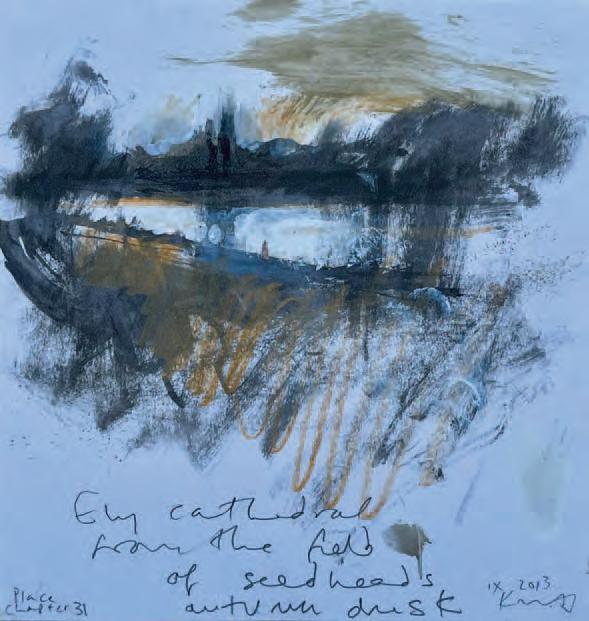
[cat.99]
Kurt Jackson (b.1961)
Ely Cathedral from the field of seed heads, autumn dusk
Signed, titled, dated IX 2013 an inscribed Place Chapter 31 Ink wash and pastel
24.5 by 23.5 cm, 9 ¾ by 9 ¼ in.
Painter, mixed media, born in Blandford, Dorset, who graduated from St Peter’s College, Oxford, in 1983 with an honours degreee in zoology and had brief periods at Hertfordshire College of Art and Ruskin School of Drawing in Oxford, under Jane Greenham, but who was essentially self-taught. After graduating, he then spent a year painting and travelling in Africa. He moved to Boscastle, Cornwall, in 1984 to paint full-time, settling in St Just, Penzance, in 1989. He was a member of RWA and Newlyn and Penwith Societies of Artists. Jackson’s work was “rooted in the Cornish land-scape, seascape and communal psyche, and the natural, human and industrial interventions in the landscape”. Group appearances included Rye Art Gallery, 1994; Leicester Art Gallery, 1995; and in 1996 the Celtic Festival at Plymouth Art Centre and Now & Then at David Messum Gallery. Had a solo show at Robinson College, Cambridge, in 1984, then exhibited prolifically, later shows including Lancashire Mining Museum, Salford. For this, Jackson went under ground to paint alongside miners at South Crofty, the last working tin mine in Cornwall. For Jackson’s exhibition The Long Field, in 2002, The Great Atlantic Map Works Gallery, St Just-in-Penwith, published a book of that title illustrating the pictures. Messum’s gave Jackson solo exhibitions in 2003, 2004 and in 2005 with a lavishly illustrated catalogue and in 2004 Newlyn Art Gallery put on his show Porth. Exeter University holds Jackson’s work.

[cat.100]
Mark Hearld (b.1974)
Tulips and Lilac
Signed with initials and dated 24
Papercut collage in a hand painted frame 91 by 71 cm, 36 by 28 in. (including frame)
Mark Hearld studied illustration at the Glasgow School of Art before completing an MA in Natural History Illustration at the Royal College of Art, London. He lives and works from his eclectic and iconic home in York.
Hearld takes inspiration from the natural world, particularly British flora and fauna, the fox and chicken, hedgerow, and songbird. He works across several mediums; his paintings, collage, printmaking, sculpture, ceramics, designs and motifs are drawn from a lifetime of looking at pattern books, popular prints, primitive art and the poetry of Blake.
Highlights of his career so far include The Lumber Room held at York Art Gallery from 2015-2017 where Mark curated a room of miscellaneous stored objects and artefacts and in 2018, Mark re-displayed the British Folk Art collection at Compton Verney. York Sculpture Park celebrated Hearld’s career in 2021 which included several large scale sculptures, flat weave tapestry and papercuts.
GUY PEPPIATT | HARRY MOORE - GWYN | FREYA MITTON
(other events are currently unconfirmed and will be announced during the year)
Guy Peppiatt
31st January to 8th February 2025
Master Drawings New YorkArader Galleries, 1016 Madison Ave, New York
February/March 2025
A Collection of Drawings by Thomas Rowlandson from a Private Collection
6 Mason’s Yard
April/May 2025
British Portrait and Figure Drawingsa joint exhibition with The Limner Company,
6 Mason’s Yard
23rd June to 11th July 2025
British Drawings and Watercolours,
6 Mason’s Yard as part of London Art Week
22nd January to 26th January 2025
London Art Fair -
Business Design CentreIslington
February/March 2025
Harry and George Sale
(general stock sale in conjunction with George Babbington) -
6 Mason’s Yard
June 2025
Harry Moore-Gwyn
British Art (1870-1970) -
6 Mason’s Yard
September 2025
Andrew Festing -
6 Mason’s Yard
25th September to 28th September 2025
British Art FairSaatchi Gallery
Freya Mitton
6th January (evening opening) to 24th January 2025
Modern British Art
6 Mason’s Yard
21st January to 26th January 2025
London Art Fair
Business Design Centre, Islington
20th March to 23rd March 2025
Cotswold Art Antiques Chelsea
Chelsea Old Town Hall
13th May to 3rd June 2025
Plant Sale: Modern British Art
6 Mason’s Yard
16th May to 19th May 2025
The Petworth Park Antiques and Fine Art Fair
25th September to 28th September 2025
British Art FairSaatchi Gallery
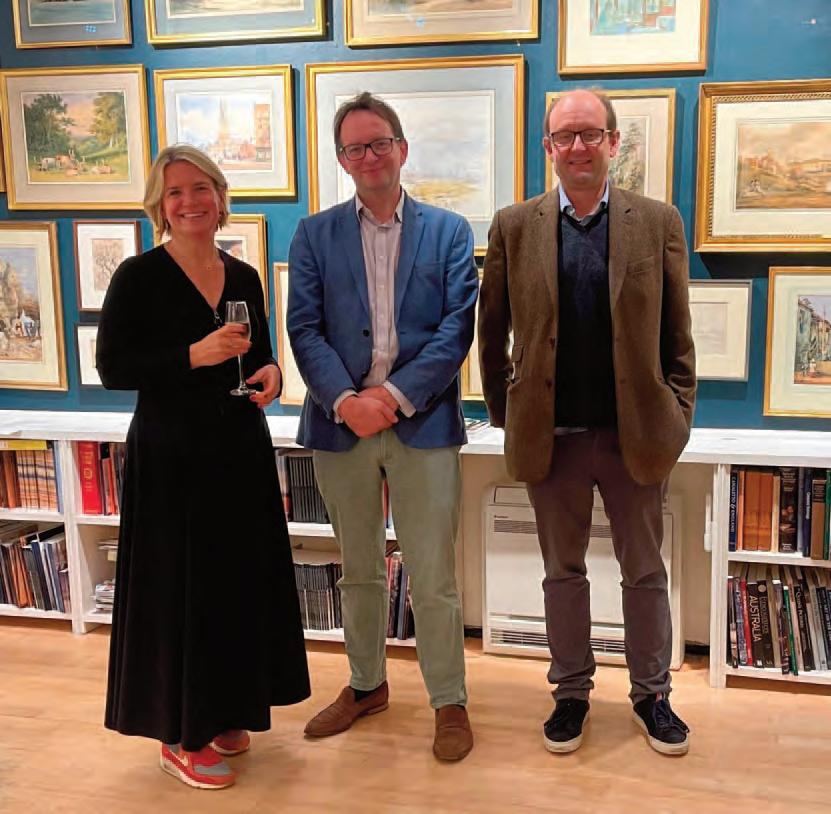
Guy Peppiatt started his working life at Dulwich Picture Gallery before joining Sotheby’s British Pictures Department in 1993. He soon specialised in early British drawings and watercolours and took over the running of Sotheby’s Topographical sales.
Guy left Sotheby’s in 2004 to work as a dealer in early British watercolours and since 2006 he has shared a gallery on the ground floor of 6 Mason’s Yard, St James’s. He advises clients and museums on their collections, buys and sells on their behalf and can provide insurance valuations. Guy Peppiatt Fine Art exhibit as part of Master Drawings New York every January as well as London Art Week in July and December.
He has recently curated an exhibition of early British watercolours at Eton College and held a loan exhibition in the gallery in 2022 - ‘Views of Nature – Four Centuries from Winchester College’. He has regular selling exhibitions in the gallery – recent ones including ‘Dr William Crotch and the Great School of Oxford’, ‘Bristol School of artists 1820-1860’, ‘Charles Gore 1729-1807’, ‘Edward Lear 1812-1888’, ‘British Portrait and Figure Drawings’ and ‘John Linnell and his Contemporaries’. He is also a Trustee of Turner’s House in Twickenham.
FREYA MITTON
Freya Mitton has been specialising in 20th Century British Art for over 25 years. She set up as an independent dealer in 2012 having previously been a specialist and auctioneer at both Sotheby’s and Bonhams.
She is a board member of the Association of Art & Antiques Dealers (LAPADA), and also a member
of the British Antique Dealers Association (BADA) and an associate member of The Cotswold Art & Antique Dealer Association.
Prior to moving into 6 Mason’s Yard Freya exhibited at over 75 Art and Antiques Fairs in London and across the country.

Harry Moore-Gwyn studied at Oxford University and Christie’s Education before working as graduate trainee at Sotheby’s London. He started dealing independently in 2000 and has since established his reputation as a dealer in British Paintings, drawings and sculpture, focusing on the period from 1870 to 1950 and with artists including the painters of the Bloomsbury and Camden Town groups, John and Paul Nash, John Piper and Graham Sutherland. He opened his first gallery on the Third floor at 6 Mason’s Yard in St James’s in 2018, moving to the Ground floor in 2021 in a space he now shares with Freya Mitton and Guy Peppiatt. He has also taken stands at many of the leading London art and antique fairs. He has a particular
interest in unsung painters of the period, publishing numerous catalogues on twentieth century British art and working with several artist’s estates amongst them James Boswell, Anthony Devas and Lowes Dalbiac Luard. In 2015 he cocurated the centenary show on Kenneth Rowntree at the Fry Art Gallery, Saffron Walden and Pallant House, Chichester, the catalogue for which was nominated for the Berger Prize for British Art History in 2016. In 2018 he curated the first major retrospective on the painter Henry Lamb for a generation at Salisbury Museum (later travelling to Poole Museum in 2019). His catalogue for this show, Henry Lamb: Out of the Shadows was published by Paul Holberton in 2018.
A
Cat No.
Alken, Henry Thomas (1785-1851) 16
Ardizzone, Edward RA (1900-1979) 46
Armfield, Maxwell
Ashby (1881-1972) 74a,b,c,d,e,f
B
Beaton, Sir Cecil (1903-1980) 52a,b
Bellany, John (1942-2013) 95
Brabazon, Hercules Brabazon (1821-1906) 29
Bratby, John RA (1928-1992) 76, 84
Buckler, John Chessell (1793-1894) 6
Burra, Edward (1905-1976) 54
Callow, William
R.W.S. (1812-1908) 18a,b, 19a,b
Cockrill, Maurice RA (1936-2013) 97
Collins, Roland (1918-2015) 61
Copnall, John (British, 1928-2007) 80, 81, 82
Cotman, John Sell (1782-1842) 5a,b
Cox, David (1783-1859) 12a,b
Cristall, Joshua
P.O.W.S. (1767–1847) 21
Crotch, Dr William (1775-1847) 8a,b
Cuming, Fred RA (1930-2022) 88
D
Daniels, Alfred (1924-2015) 94
Davie, Alan (1920-2014) 72
Dobson, Frank RA (1886-1963) 68
Duranty, Charles (1918-2006) 77a,b,c
E
Epstein, Sir Jacob (1880-1959) 55b
Evans, William (1809-1858) 13
Fahey, Edward Henry (1844-1907) 26
Fedden, Mary RA (1915-2012) 98
Freud, Lucian OM, CH (1922-2011) 57
Fripp, George Arthur R.W.S. (1813-1896) 20a,b
Frost, Sir Terry RA (1915-2003) 85a,b,c,d,e
Fulleylove, John (1845-1908) 30
GCat No.
Garden, William Fraser (1856-1921) 35
Gear, William RA (1915-1997) 69
Gentleman, David (born 1930) 66a,b
Gibb, Harry Phelan (1870-1948) 39
Gibbings, Robert (1889-1958) 62
Goodwin, Albert R.W.S. (1845-1932) 27, 28
Green, William (1760-1823) 9a,b,c Grimm, Samuel Hieronymus (1733-1798) 2
Halliwell, Albert Edward (1905-1987) 67a Halliwell, Doris Irene (1908-1988) 67b Hayter, John (1800-1895) 7 Hearld, Mark (b.1974) 100
Herman, Josef (1911-2000) 70
Higton, John (1775-1827) 15 Hilditch, George (1803-1857) 10 Hilton, Rose (1931-2019) 91, 92, 93 Holzhandler, Dora (1928-2015) 86, 87
Hughes, Edward Robert RWS (1851-1914) 37
JJackson, Kurt (b.1961) 99 Jones, Barbara (1912-1978) 50
KKnights, Winifred (1899-1947) 44 Kramer, Jacob (1892-1962) 53
Landseer, Sir Edwin Henry R.A. (1802-1873) 17a,b Lear, Edward (1812-1888) 23, 34 Livens, Horace Mann (1862-1940) 48 Loggon, Thomas (1706-1780) 1
M
Millais, Sir John Everett Bt. PRA (1829-1896) 36
Moore, Henry OM, CH (1898-1986) 56
Moore, Henry R.A., R.W.S. (1831-1895) 25
Nash, John RA (1893-1977) 45c Nash, Paul (1889-1946) 45a,b
O Cat No. O’Casey, Breon (1928-2011) 96a,b,c,d
P
Pailthorpe, Grace (1883-1971) 73
Paolozzi, Sir Eduardo RA (1924-2005) 83
Penley, Edwin Aaron (1826-1893) 22 Piper, John CH (1903-1992) 59a,b, 71, 79
Pryde, James (1866-1941) 40a,b
R
Robertson, Eric Macbeth (1887-1941) 42
Rogers, Claude (1907-1979) 64
Romney, George (1734-1802) 3a, 3b
Rossiter, Anthony (1926-2000) 89, 90
Ryan, Adrian (1920-1988) 78
S
Sickert, Walter RA (1860-1943) 41
Sims, Charles RA, RWS (1873-1928) 38
Smith, Sir Matthew (1879-1959) 55a
Spear, Ruskin (1911-1990) 75
Spencer, Sir Stanley RA (1891-1959) 47
Sutherland, Graham OM (1903-1980) 60a,b
TTavener, Robert RE (1920-2004) 65a,b
Thomas, Fanny Elizabeth (1851-1925) 31a,b
Thorburn, Archibald (1860-1855) 33
Tudor, Thomas (1785-1855) 4a,b
Tunnicliffe, Charles Frederick R.A. (1901-1979) 32
Turner, William (1789-1862) 14
VVarley, John (1778-1842) 11a,b Vaughan, Keith (1912-1977) 58a,b
W
Werner, Carl Frederick Heinrich (1808-1894) 24
Whistler, Rex (1905-1944) 49
White, Ethelbert RWS (1891-1972) 51a,b
White, Peter (1929-2016) 63
Y
Yeats, Jack Butler (1871-1957) 43
Tel: +44 (0)7765
Tel: +44 (0) 20 7930 3839 or +44 (0) 7956 968 284 guy@peppiattfineart.co.uk www.peppiattfineart.co.uk
